Paul van Yperen's Blog, page 244
February 10, 2019
Olivia de Havilland
Olivia de Havilland (1916) is a Japanese-born British-American former actress, whose career spanned from 1935 to 1988. She appeared in 49 feature films, and was one of the leading stars during the golden age of Classical Hollywood. She is best known for her early screen performances in The Adventures of Robin Hood (1938) and Gone with the Wind (1939), and her later award-winning performances in To Each His Own (1946), The Snake Pit (1948), and The Heiress (1949).

Belgian postcard by Victoria, Brussels, no. 639/24. Photo: Paramount.

British Real Photo postcard, no. 163. Photo: Warner Bros. / Vitaphone Pictures.

French postcard by Viny, no. 124. Photo: Warner Bros.

British Real Photograph postcard, no. 253.

German postcard by Kolibri-Verlag, no. 294. Photo: Paramount.
An intense crush on Errol Flynn
Olivia Mary de Havilland was born in 1916, in Tokyo, Japan, to British parents. Her mother was the former film and stage actress Lilian Fontaine (Lilian Augusta Ruse), and her father was an English professor and patent attorney, Walter Augustus de Havilland. He was the author of the 1910 book The ABC of Go, which provides a detailed and comprehensive description of the Japanese board game. Her sister, Joan, later to become famous as Joan Fontaine, was born the following year.
Her surname comes from her paternal grandfather, whose family was from Guernsey in the Channel Islands. Her parents divorced when Olivia was just three years old, and she moved with her mother and sister to Saratoga, California. At her high school, she fell prey to the acting bug. She made her acting debut in amateur theatre in Alice in Wonderland.
After graduating, Olivia enrolled in Mills College in Oakland, where she participated in the school play A Midsummer Night's Dream and was spotted by Austrian director Max Reinhardt. She so impressed Reinhardt that he picked her up for both his stage version and, later, the Warner Bros. film version in 1935. She again was so impressive that Warner executives signed her to a seven-year contract.
No sooner had the ink dried on the contract than Olivia appeared in three more films: The Irish in Us (Lloyd Bacon, 1935) with James Cagney, Alibi Ike (Ray Enright, 1935), and Captain Blood (Michael Curtiz, 1935), with the man with whom her career would be most closely identified, heartthrob Errol Flynn .
They acted together in seven more films: The Adventures of Robin Hood (Michael Curtiz, William Keighley, 1938), The Charge of the Light Brigade (Michael Curtiz, 1936), Four's a Crowd (Michael Curtiz, 1938), Dodge City (Michael Curtiz, 1939), The Private Lives of Elizabeth and Essex (Michael Curtiz, 1939), Santa Fe Trail (Michael Curtiz, 1940), and They Died with Their Boots On (Raoul Walsh, 1941). Both are also featured in a ninth film, Thank Your Lucky Stars (David Butler, 1943), although in separate scenes. Years later, she confessed that she had an intense crush on Errol Flynn during the years of their filming, saying that it was hard to resist his charms.

French postcard, no. 706. Photo: Warner Bros.

French postcard by Viny, no. 124. Photo: Warner Bros.

French postcard by Editions P.I., Paris, no. 285. Photo: Warner Bros.

Vintage postcard. Photo: publicity still for The Charge of the Light Brigade (1936).
An all-out feud between two sisters
Olivia de Havilland achieved her initial popularity in romantic comedy films, such as The Great Garrick (1937), directed by James Whale. In 1939 Warner Bros. loaned her to David O. Selznick for the classic Gone with the Wind (Victor Fleming, 1939). Playing the sweet Melanie Hamilton, Olivia received her first nomination for an Academy Award for Best Supporting Actress, only to lose out to one of her co-stars in the film, Hattie McDaniel.
After GWTW, Olivia returned to Warner Bros. and continued to churn out films. In 1941 she played Emmy Brown opposite Charles Boyer in Hold Back the Dawn (Mitchell Leisen, 1941), which resulted in her second Oscar nomination, this time for Best Actress. Again she lost, this time to her sister Joan Fontaine for her role in Suspicion (Alfred Hitchcock, 1941).
Relations between the sisters were never strong and their mutual dislike and jealousy escalated into an all-out feud after Fontaine won the Oscar. Despite the fact that de Havilland went on to win two Academy Awards of her own, they remained estranged. In a rare act of reconciliation, Olivia and her sister Joan celebrated Christmas 1962 together along with their then-husbands and children.
Denny Jackson at IMDb : "After that strong showing (in Hold Back the Dawn), Olivia now demanded better, more substantial roles than the "sweet young thing" slot into which Warners had been fitting her. The studio responded by placing her on a six-month suspension, all of the studios at the time operating under the policy that players were nothing more than property to do with as they saw fit.
As if that weren't bad enough, when her contract with Warners was up, she was told that she would have to make up the time lost because of the suspension. Irate, she sued the studio, and for the length of the court battle she didn't appear in a single film. The result, however, was worth it. In a landmark decision, the court said not only that de Havilland did not have to make up the time, but that all performers were to be limited to a seven-year contract that would include any suspensions handed down. This became known as the 'de Havilland decision'; no longer could studios treat their performers as mere cattle."

British postcard in the Picturegoer Series, London, no. W. 348. Photo: David O'Selznick Production / Metro-Goldwyn-Mayer. Publicity still for Gone with the Wind (Victor Fleming, 1939) with Leslie Howard .

British postcard in the Picturegoer Series, London, no. W. 345. Photo: David O'Selznick Production / Metro-Goldwyn-Mayer. Publicity still for Gone with the Wind (Victor Fleming, 1939) with Leslie Howard and Vivien Leigh . Caption: Bridal scene from Gone with the Wind.

Romanian postcard by Casa Filmului Acin, no. 247. Photo: publicity still for Gone with the Wind (Victor Fleming, 1939) with Leslie Howard .

Belgian collectors card by De Beukelaer, Antwerp, no. A 35. Photo: Paramount. De Havilland is dressed in an outfit for The Heiress (William Wyler, 1949).
The Oldest Dame Commander of the Order of the British Empire
Returning to screen in 1946, Olivia de Havilland made up for lost time by appearing in four films, one of which finally won her the Oscar that had so long eluded her. It was the romantic drama To Each His Own (Mitchell Leisen, 1946), in which she played Josephine Norris to the delight of critics and audiences alike. Olivia was the strongest performer in Hollywood for the balance of the 1940s.
In 1948 she turned in another strong showing in The Snake Pit (Anatole Litvak, 1948) as Virginia Cunningham, a woman suffering a mental breakdown. The end result was another Oscar nomination for Best Actress, but she lost to Jane Wyman in Johnny Belinda (Jean Negulesco, 1948). As in the two previous years, she made only one film in 1949, but she again won a nomination and the Academy Award for Best Actress for The Heiress (William Wyler, 1949) with Montgomery Clift.
After a three-year hiatus, de Havilland returned to star in My Cousin Rachel (Henry Koster, 1952) with Richard Burton . From that point on, she made few appearances on the screen but was seen on Broadway and in some television shows. In the cinema, she was seen in the romantic drama Light in the Piazza (Guy Green, 1962), and the psychological thriller Hush… Hush, Sweet Charlotte (Robert Aldrich, 1964) opposite Bette Davis .
Her last screen appearance was as the Queen Mother in The Fifth Musketeer (Ken Annakin, 1979), and her final career appearance was in the TV movie The Woman He Loved (Charles Jarrott, 1988) about the love story between American divorcee Wallis Simpson and Edward VII.
Olivia de Havilland married and divorced twice: her first husband was writer Marcus Goodrich (1946-1953) and her second writer-husband was Pierre Galante (1955-1979), an executive editor for the French journal Paris Match. With both husbands, she had a child. She lost her son, Benjamin Goodrich (1949), to Hodgkin's disease in 1991. With Galante, she had daughter Gisèle Galante (1956). The former couple remained close friends, and after Galante became ill with cancer, she nursed him until his death in 1998.
Since the mid-1950s, she lives in Paris in France. In 1962, she showed flair as a writer with 'Every Frenchman Has One', a light-hearted autobiographical account of her attempts at adapting to French life. Two weeks before her 101st birthday, she was appointed Dame Commander of the Order of the British Empire in the 2017 Birthday Honours by Queen Elizabeth II for services to Drama. She is the oldest woman ever to receive the honour. In a statement, she called it "the most gratifying of birthday presents." Today, Olivia de Havilland enjoys a quiet retirement in Paris.

Dutch postcard by Foto-archief Film en Toneel, no. 3283. Photo: Paramount.

Dutch postcard by DRC. Photo: Paramount / mpea.

French postcard by Editions P.I., no. 285. Photo: Paramount Pictures, 1950.

French postcard by Editions P.I., Paris, offered by Les Carbone Korès 'Carboplane', no. 328. Photo: Paramount, 1953.
Sources: (IMDb), Wikipedia and .

Belgian postcard by Victoria, Brussels, no. 639/24. Photo: Paramount.

British Real Photo postcard, no. 163. Photo: Warner Bros. / Vitaphone Pictures.

French postcard by Viny, no. 124. Photo: Warner Bros.

British Real Photograph postcard, no. 253.

German postcard by Kolibri-Verlag, no. 294. Photo: Paramount.
An intense crush on Errol Flynn
Olivia Mary de Havilland was born in 1916, in Tokyo, Japan, to British parents. Her mother was the former film and stage actress Lilian Fontaine (Lilian Augusta Ruse), and her father was an English professor and patent attorney, Walter Augustus de Havilland. He was the author of the 1910 book The ABC of Go, which provides a detailed and comprehensive description of the Japanese board game. Her sister, Joan, later to become famous as Joan Fontaine, was born the following year.
Her surname comes from her paternal grandfather, whose family was from Guernsey in the Channel Islands. Her parents divorced when Olivia was just three years old, and she moved with her mother and sister to Saratoga, California. At her high school, she fell prey to the acting bug. She made her acting debut in amateur theatre in Alice in Wonderland.
After graduating, Olivia enrolled in Mills College in Oakland, where she participated in the school play A Midsummer Night's Dream and was spotted by Austrian director Max Reinhardt. She so impressed Reinhardt that he picked her up for both his stage version and, later, the Warner Bros. film version in 1935. She again was so impressive that Warner executives signed her to a seven-year contract.
No sooner had the ink dried on the contract than Olivia appeared in three more films: The Irish in Us (Lloyd Bacon, 1935) with James Cagney, Alibi Ike (Ray Enright, 1935), and Captain Blood (Michael Curtiz, 1935), with the man with whom her career would be most closely identified, heartthrob Errol Flynn .
They acted together in seven more films: The Adventures of Robin Hood (Michael Curtiz, William Keighley, 1938), The Charge of the Light Brigade (Michael Curtiz, 1936), Four's a Crowd (Michael Curtiz, 1938), Dodge City (Michael Curtiz, 1939), The Private Lives of Elizabeth and Essex (Michael Curtiz, 1939), Santa Fe Trail (Michael Curtiz, 1940), and They Died with Their Boots On (Raoul Walsh, 1941). Both are also featured in a ninth film, Thank Your Lucky Stars (David Butler, 1943), although in separate scenes. Years later, she confessed that she had an intense crush on Errol Flynn during the years of their filming, saying that it was hard to resist his charms.

French postcard, no. 706. Photo: Warner Bros.

French postcard by Viny, no. 124. Photo: Warner Bros.

French postcard by Editions P.I., Paris, no. 285. Photo: Warner Bros.

Vintage postcard. Photo: publicity still for The Charge of the Light Brigade (1936).
An all-out feud between two sisters
Olivia de Havilland achieved her initial popularity in romantic comedy films, such as The Great Garrick (1937), directed by James Whale. In 1939 Warner Bros. loaned her to David O. Selznick for the classic Gone with the Wind (Victor Fleming, 1939). Playing the sweet Melanie Hamilton, Olivia received her first nomination for an Academy Award for Best Supporting Actress, only to lose out to one of her co-stars in the film, Hattie McDaniel.
After GWTW, Olivia returned to Warner Bros. and continued to churn out films. In 1941 she played Emmy Brown opposite Charles Boyer in Hold Back the Dawn (Mitchell Leisen, 1941), which resulted in her second Oscar nomination, this time for Best Actress. Again she lost, this time to her sister Joan Fontaine for her role in Suspicion (Alfred Hitchcock, 1941).
Relations between the sisters were never strong and their mutual dislike and jealousy escalated into an all-out feud after Fontaine won the Oscar. Despite the fact that de Havilland went on to win two Academy Awards of her own, they remained estranged. In a rare act of reconciliation, Olivia and her sister Joan celebrated Christmas 1962 together along with their then-husbands and children.
Denny Jackson at IMDb : "After that strong showing (in Hold Back the Dawn), Olivia now demanded better, more substantial roles than the "sweet young thing" slot into which Warners had been fitting her. The studio responded by placing her on a six-month suspension, all of the studios at the time operating under the policy that players were nothing more than property to do with as they saw fit.
As if that weren't bad enough, when her contract with Warners was up, she was told that she would have to make up the time lost because of the suspension. Irate, she sued the studio, and for the length of the court battle she didn't appear in a single film. The result, however, was worth it. In a landmark decision, the court said not only that de Havilland did not have to make up the time, but that all performers were to be limited to a seven-year contract that would include any suspensions handed down. This became known as the 'de Havilland decision'; no longer could studios treat their performers as mere cattle."

British postcard in the Picturegoer Series, London, no. W. 348. Photo: David O'Selznick Production / Metro-Goldwyn-Mayer. Publicity still for Gone with the Wind (Victor Fleming, 1939) with Leslie Howard .

British postcard in the Picturegoer Series, London, no. W. 345. Photo: David O'Selznick Production / Metro-Goldwyn-Mayer. Publicity still for Gone with the Wind (Victor Fleming, 1939) with Leslie Howard and Vivien Leigh . Caption: Bridal scene from Gone with the Wind.

Romanian postcard by Casa Filmului Acin, no. 247. Photo: publicity still for Gone with the Wind (Victor Fleming, 1939) with Leslie Howard .

Belgian collectors card by De Beukelaer, Antwerp, no. A 35. Photo: Paramount. De Havilland is dressed in an outfit for The Heiress (William Wyler, 1949).
The Oldest Dame Commander of the Order of the British Empire
Returning to screen in 1946, Olivia de Havilland made up for lost time by appearing in four films, one of which finally won her the Oscar that had so long eluded her. It was the romantic drama To Each His Own (Mitchell Leisen, 1946), in which she played Josephine Norris to the delight of critics and audiences alike. Olivia was the strongest performer in Hollywood for the balance of the 1940s.
In 1948 she turned in another strong showing in The Snake Pit (Anatole Litvak, 1948) as Virginia Cunningham, a woman suffering a mental breakdown. The end result was another Oscar nomination for Best Actress, but she lost to Jane Wyman in Johnny Belinda (Jean Negulesco, 1948). As in the two previous years, she made only one film in 1949, but she again won a nomination and the Academy Award for Best Actress for The Heiress (William Wyler, 1949) with Montgomery Clift.
After a three-year hiatus, de Havilland returned to star in My Cousin Rachel (Henry Koster, 1952) with Richard Burton . From that point on, she made few appearances on the screen but was seen on Broadway and in some television shows. In the cinema, she was seen in the romantic drama Light in the Piazza (Guy Green, 1962), and the psychological thriller Hush… Hush, Sweet Charlotte (Robert Aldrich, 1964) opposite Bette Davis .
Her last screen appearance was as the Queen Mother in The Fifth Musketeer (Ken Annakin, 1979), and her final career appearance was in the TV movie The Woman He Loved (Charles Jarrott, 1988) about the love story between American divorcee Wallis Simpson and Edward VII.
Olivia de Havilland married and divorced twice: her first husband was writer Marcus Goodrich (1946-1953) and her second writer-husband was Pierre Galante (1955-1979), an executive editor for the French journal Paris Match. With both husbands, she had a child. She lost her son, Benjamin Goodrich (1949), to Hodgkin's disease in 1991. With Galante, she had daughter Gisèle Galante (1956). The former couple remained close friends, and after Galante became ill with cancer, she nursed him until his death in 1998.
Since the mid-1950s, she lives in Paris in France. In 1962, she showed flair as a writer with 'Every Frenchman Has One', a light-hearted autobiographical account of her attempts at adapting to French life. Two weeks before her 101st birthday, she was appointed Dame Commander of the Order of the British Empire in the 2017 Birthday Honours by Queen Elizabeth II for services to Drama. She is the oldest woman ever to receive the honour. In a statement, she called it "the most gratifying of birthday presents." Today, Olivia de Havilland enjoys a quiet retirement in Paris.

Dutch postcard by Foto-archief Film en Toneel, no. 3283. Photo: Paramount.

Dutch postcard by DRC. Photo: Paramount / mpea.

French postcard by Editions P.I., no. 285. Photo: Paramount Pictures, 1950.

French postcard by Editions P.I., Paris, offered by Les Carbone Korès 'Carboplane', no. 328. Photo: Paramount, 1953.
Sources: (IMDb), Wikipedia and .
Published on February 10, 2019 22:00
February 9, 2019
Photo by The Rank Organisation
The Rank Organisation dominated British cinema throughout the 1930s, 1940s, 1950s and to some extent the 1960s. The British entertainment conglomerate was founded by industrialist J. Arthur Rank in April 1937. It quickly became the largest and most vertically integrated film company in Great Britain, owning production, distribution and exhibition facilities. During the 1940s, the companies Rank controlled produced some of the finest British films of the period. From the 1950s fewer adventurous films were attempted and solidly commercial ventures, largely aimed at the family market, were made instead. Rank diversified into the manufacture of radios, TVs and photocopiers (as one of the owners of Rank Xerox).

British postcard by Rotary Photo, London, no. F.S. 18. Caption: John Mills with his small daughter 'Bunch' in the studio. The picture was taken during the shooting of Great Expectations (David Lean, 1946). At the time, Juliet Mills (or Bunch) must have been four years old.

British postcard in the Picturegoer Series, London, no. W. 654. Photo: J. Arthur Rank Organisation Ltd. Publicity still for The Red Shoes (Michael Powell, Emeric Pressburger, 1948) with Moira Shearer .

British postcard in the Picturegoer series, London, no. W 343. Photo: Cannons. Publicity still for Black Narcissus (Michael Powell, Emeric Pressburger, 1947) with Sabu .

Italian postcard by Bromofoto, Milano, no. 214. Photo: Victory Rank. Publicity still for Hamlet (Laurence Olivier, 1948) with Laurence Olivier .

British postcard in the Picturegoer Series, London, no. D 554. Photo: J. Arthur Rank Organisation. Publicity still for Romeo and Juliet (1954) with Laurence Harvey and Susan Shentall.
A Methodist Millionaire spreading the Gospel through Films
Lord J. Arthur Rank, born in Kingston upon Hull, UK, was a wealthy industrialist through his father's flour milling business, Joseph Rank Ltd. He made his somewhat unlikely start in film-making, financing short religious subjects in line with his Methodist beliefs. During the 1920s he had owned a Methodist newspaper, and when he realised the value of films in Sunday school instruction, he entered the film business with British National Pictures in order to improve the quality of these religious films. From these modest origins, the British film company emerged in 1937 as Rank sought to consolidate his film-making interests.
The company logo, the Gongman, was first used in 1935 by the group's distribution company General Film Distributors and seen in the opening titles of the films. Rank originally wanted a wolf to rival the MGM lion, as the opening trademark of his films. The only wolf available was rather mangy-looking. Someone suggested they bang a gong. The gongs used in the famous opening were actually made of papier-mache, and the strongmen like Bombadier Billy Wells simply mimed their strikes. It became a celebrated and enduring film emblem.
J. Arthur Rank had entered the film industry with the intention of making films with strong religious and moral themes, but realised early on that this kind of subject was unlikely to be very profitable. Consequently, Rank went on to make an enormous number of films with a very wide appeal. One of the first Rank films was the comedy Oh, Mr Porter! (Marcel Varnel, 1937) starring Will Hay. It grossed £500,000 at the box office – equal to over £30,000,000 in modern-day money. Oh, Mr Porter! is probably his best-known film to modern audiences. The plot of Oh, Mr Porter was loosely based on the Arnold Ridley play The Ghost Train. It is widely acclaimed as the best of Hay's work, and a classic of its genre. In the following years, Hay made for Rank the comedies Hey! Hey! USA (Marcel Varnel, 1938) and Ask a Policeman (Marcel Varnel, 1939).
The Rank company grew quickly, largely through acquisition. In 1938, the Odeon Cinemas chain was purchased. The chain was started by Oscar Deutsch (ODEON was an acronym for 'Oscar Deutsch Entertains Our Nation'). With builder Charles Boot, Rank bought the grounds of an old Victorian house (Heatherden Hall) in Hertfordshire and turned it into Pinewood Studios. After Alexander Korda ran into financial difficulties, Rank also bought Denham Studios. These were merged with the facilities at Pinewood and the Amalgamated Studios in Borehamwood were acquired, but not used for making films. Also in 1939, the British sites of Paramount Cinemas were purchased. Two years later followed the purchase of the Gaumont-British Picture Corporation, which also owned Gainsborough Pictures, 251 cinemas and the Lime Grove Studios.
During the Second World War, Rank produced the patriotic war film In Which We Serve (Noël Coward, David Lean, 1942). It was made with the assistance of the Ministry of Information. The screenplay by Noël Coward was inspired by the exploits of Captain Lord Louis Mountbatten, who was in command of the destroyer HMS Kelly when it was sunk during the Battle of Crete. Coward composed the film's music as well as starring in the film as the ship's captain. The film also starred John Mills , Bernard Miles, Celia Johnson and Richard Attenborough in his first screen role. The film was the second most popular movie at the British box office in 1943, and remains a classic example of wartime British cinema through its patriotic imagery of national unity and social cohesion within the context of the war.
In 1944, Rank produced the Technicolor film adaptation of William Shakespeare's play Henry V (1944). It stars Laurence Olivier , who also directed. The film begins as a recreation of a stage production of the play in the Globe Theatre, then gradually turns into a stylised cinematic rendition of the play, with sets reminiscent of a medieval Book of Hours. Henry V was intended as a morale booster for Britain, and partly funded by the British government. The film won Olivier an Academy Honorary Award for "his Outstanding achievement as actor, producer and director in bringing Henry V to the screen." It was the first Shakespeare film to be both critically and commercially successful.

Trevor Howard . Dutch postcard, no. AX 289. Photo: Cornel Lucas / J. Arthur Rank Organisation.

Valerie Hobson . Dutch postcard. Photo: J. Arthur Rank.

Richard Attenborough . British postcard by Show Parade Picture Service, London, in the series 'The People', no. P1065. Photo: J. Arthur Rank Organisation Ltd.

Moira Shearer . British postcard by 'The People' Show Parade Picture Service, London, no. P. 1041. Photo: J. Arthur Rank Organisation Ltd.

Anton Walbrook . British postcard in the Picturegoer Series, London, no. W. 432. Photo: J. Arthur Rank Organization Ltd.
The Classics of the Independent Producers
One of the best things about filmmaking for Rank was the freedom given to talented directors that allowed them to make some of the most successful and spectacular films ever made in Britain. After the war, a loose collective of film makers was established under the banner of Independent Producers Ltd. In 1945, Michael Powell and Emeric Pressburger made the romance I Know Where I'm Going! starring Wendy Hiller and Roger Livesey, David Lean directed the romantic drama Brief Encounter (1945) about British suburban life on the eve of World War 2, with Trevor Howard and Celia Johnson . In the next year followed two more classics, Great Expectations (David Lean, 1946), based on the novel by Charles Dickens and starring John Mills , and the fantasy-romance A Matter of Life and Death (Michael Powell, Emeric Pressburger, 1946), set in England during the Second World War, and starring David Niven .
In the following years, Independent Producers delivered more classics like Black Narcissus (Michael Powell, Emeric Pressburger, 1947) with Deborah Kerr , Jean Simmons and Sabu , and The Red Shoes (Michael Powell, Emeric Pressburger, 1948), with Moira Shearer and Anton Walbrook . The duo Frank Launder and Sidney Gilliat came with the spy film I See a Dark Stranger (1946) and the comedy The Happiest Days of Your Life) (1950) with Alastair Sim and Margaret Rutherford. Ken Annakin made the comedy Holiday Camp (1947) with Flora Robson , and Muriel Box directed the melodrama The Seventh Veil (1945) with James Mason and Ann Todd .
In the mid-1940s Two Cities Films became part of the Rank Organisation producing key films such as the Film Noir Odd Man Out (Carol Reed, 1947) featuring James Mason , Hamlet (Laurence Olivier, 1948), the comedy Vice Versa (Peter Ustinov, 1948) and the fantasy The Rocking Horse Winner (Anthony Pelissier, 1949). In 1946, Rank bought for £1 million+ a 50 per cent share in a chain of 133 cinemas from New Zealander Robert James Kerridge, the biggest exhibition chain in Australasia; it was renamed Kerridge Odeon. In the late 1940s, a majority shareholding in Allied Cinemas and Irish Cinemas Ltd was gained, thus becoming the largest exhibition circuit in Ireland. Rank maintained this position maintained until the early 1980s.
So by the late 1940s J Arthur Rank (or the Rank Organisation as it was now called), owned five major film studio complexes, Pinewood Film Studios, Denham Film Studios, Ealing Studios, Lime Grove Studios and Islington Studios. (The studios at Lime Grove were sold to the BBC in 1949.) Rank owned 650 UK cinemas (the Odeon, Gaumont and Paramount chains) plus various international holdings, including subsidiaries in Canada and The Netherlands, and General Film Distributors (later Rank Film Distributors), including the UK distribution rights to Universal Pictures.
In 1945, the Company of Youth, the Rank Organisation acting school often referred to as 'The Charm School, was founded. It launched several careers including those of Donald Sinden, Dirk Bogarde , Diana Dors and Christopher Lee . Although she was not a member of the school, Petula Clark was under contract to Rank for a period of time and starred in a number of films released by the studio, including London Town (Wesley Ruggles, 1946), one of the costliest flops in British film history. Also under contract to Rank was the Canadian actor Philip Gilbert.

Petula Clark . Italian postcard by Rotalfoto, Milano, no. 129. Photo: Rank Film. Publicity still for The Card (Ronald Neame, 1952).

Dirk Bogarde . British Greetings card, no. E. Photo: J. Arthur Rank Organisation.

Diana Dors . Italian postcard by Rotalfoto, Milano, no. 536. Photo: Rank.

Anthony Steel . British postcard in the Picturegoer Series, London, no. D 140. Photo: J. Arthur Rank Organisation.

Jean Simmons . German postcard by F.J. Rüdel Filmpostkartenverlag, Hamburg-Bergedorf, no. 115. Photo: J. Arthur Rank Organisation.
Aiming at the family market
Despite backing some excellent films, Rank was in crisis by 1949. An over-ambitious attempt to expand into America had brought Rank to near bankruptcy. He had built up a debt of £16 million, and the studio reported an annual loss of £3.5 million. Managing Director John Davis cut staff, reduced budgets and concentrated film production at Pinewood. Other studio facilities (in Islington) were closed, sold (Lime Grove Studios) or leased (Denham). The Rank Organisation closed Independent Producers Ltd. The policies of Davis alienated many in the industry, in particular they led film director David Lean, responsible for some of Rank's most critically and financially successful films, to look elsewhere for backing.
In 1949, the company bought the Bush Radio manufacturing facility and began to diversify its interests. In the early 1960s Rank took over Murphy Radio to form the Rank Bush Murphy Group which was eventually sold to Great Universal Stores in 1978. In 1956 Rank began a partnership with the Haloid Corporation to form Rank Xerox. Rank was also a significant shareholder in the consortium which became Southern Television, the first ITV television contract holder for the south of England. In the late 1950s, Rank set up Rank Records Ltd. (the record label was named Top Rank) and Jaro Records (a US subsidiary). In 1960, Top Rank was taken over by EMI, and in 1962 they replaced it with Stateside Records. Top Rank artists included Gary U.S. Bonds, the Shirelles, B. Bumble and the Stingers, and John Leyton.
From the 1950s, fewer adventurous films were produced and solidly commercial ventures, largely aimed at the family market, were made instead. These include the popular Norman Wisdom comedies, the Doctor films series with Dirk Bogarde . and, later, Rank took on the Carry On film series. However some films of note were produced during this era including The Browning Version (Anthony Asquith, 1951), the comedy Genevieve (Henry Cornelius, 1953) and Reach for the Sky (Lewis Gilbert, 1956), as well as a clutch of prestige topics such as the Coronation of Queen Elizabeth II and filmed performances by the Royal Ballet.
During the 1950s the British photographer Cornel Lucas set up the Pool Studio at Pinewood where he photographed many of the film stars of this era of cinema, such as Diana Dors , Marlene Dietrich , David Niven and Lucas' wife Belinda Lee.
J. Arthur Rank had stepped down as managing director of the Rank Organisation in 1952, but remained as chairman until 1962. In 1960, Rank Audio Visual was created, bringing together Rank's acquisitions in multimedia, including Bell & Howell (acquired with Gaumont British in 1941), Andrew Smith Harkness Ltd (1952) and Wharfedale Ltd (1958). Subsequent acquisitions included Strand Electric Holdings (1968) and H.J. Leak & Co. (1969). In the mid and late 1970s, Rank Audio Visual made a 3-in-1 stereo music centre, as well as TV sets in conjunction with NEC of Japan. The production of the 'classic' Rank TV ran in the mid to late 70s, some interim models appeared and the 'modern' Rank TV appeared in the early 1980s.

Susan Shaw . Dutch postcard, no. AX 495. Photo: J. Arthur Rank Organisation.

Norman Wisdom . German postcard by Ufa, Berlin-Tempelhof, no. FK 988. Photo: J. Arthur Rank Organisation. Publicity still for Trouble in Store (John Paddy Carstairs, 1953).

Laurence Harvey . German postcard by Ufa, Berlin-Tempelhof, no. FK 1322. Photo: J. Arthur Rank Organisation. Publicity still for Romeo and Juliet (1954).

Diana Dors German postcard by Ufa, Berlin-Tempelhof, no. FK 2061. Photo: J. Arthur Rank Organisation.

Belinda Lee . German postcard by Kolibri-Verlag G.m.b.H, Minden/Westf., no. 2720. Photo: Cornel Lucas / J. Arhur Rank Organisation.
A deliberately downbeat alternative to 007
In 1960, John Davis announced that Rank would concentrate on bigger budgeted, internationally focused productions. In 1961 they announced a production slate of a dozen films worth £7 million. From 1959 to 1969: the company made over 500 weekly short cinema films in a series entitled Look At Life, each film depicting an area of British life. Unfortunately, Rank failed to invest in television when the medium was becoming increasingly popular and cinema audiences were declining.
A highlight of the Rank film production during the 1960s was the espionage film The Ipcress File (Sidney J. Furie, 1965) starring Michael Caine . The screenplay, by Bill Canaway and James Doran, was based on Len Deighton's novel, The IPCRESS File (1962). It received a BAFTA award for the Best British film released in 1965. This film and its sequels were a deliberately downbeat alternative to the hugely successful James Bond films, even though one of the Bond producers, Harry Saltzman, was involved with the Harry Palmer series, along with other personnel who had been contracted to work on one or more of the 007 movies.
From 1971 to 1976 Rank only invested around £1.5 million a year in film production. According to executive Tony Williams "the two main streams that they were down to was Carry On pictures and horror films made by Kevin Francis". However, in 1976 Rank enjoyed much success with Bugsy Malone (Alan Parker, 1976) which they co-produced with Paramount Pictures. It features only child actors with Scott Baio and Jodie Foster in pivotal roles. This success encouraged Rank to re-enter film production.
In 1977 Rank appointed Tony Williams head of production and over two years Rank made eight films worth £10 million, including the horror film The Shout (Jerzy Skolimowski, 1978), the thriller The Thirty Nine Steps (Don Sharp, 1978), and the spy thriller Riddle of the Sands (Tony Maylam, 1979) with Michael York . One of the more interesting productions was psychological thriller Bad timing (Nicolas Roeg, 1980), starring Art Garfunkel and Theresa Russell. Many of these stories were set in the past. Few of these new Rank films performed well at the box office, losing £1.6 million over all. (The company's pre-tax profit was £131 million.)
At the Cannes Film Festival in 1980 Ed Chilton of Rank announced a £12 million slate of projects. However, by June they withdrew from production once again. Rank's final production was the motorracing film Silver Dream Racer (1980) starring British pop star David Essex. The Rank films that had been announced for production were cancelled. After a time Rank Film Distributors was in trouble because they hadn’t got any new product. They did an output deal with Orion.
In 1995, the Rank Group acquired all the outstanding shares of the Rank Organisation. In spring 1997, Rank sold Rank Film Distributors, including its library of 749 films, to Carlton Television for £65 million and immediately became known as Carlton/RFD Ltd. Pinewood Studios and Odeon Cinemas were both sold off in 2000. The company finally severed its remainings connection with the film industry in 2005 when it sold its DVD distribution business and Deluxe technical support unit.

Peggy Cummins . Italian postcard by Bromofoto, Milano, no. 673. Photo: Rank Film.

Terence Morgan . Italian postcard by Bromofoto, Milano, no. 1004. Photo: Rank Film. Publicity still for Dance Little Lady (Val Guest, 1954).

Jack Hawkins. Italian postcard by Bromofoto, Milano, no. 1288. Photo: Rank Film. Publicity still for The Long Arm (Charles Frend, 1956).

Maureen Swanson . Italian postcard by B.F.F. Edit., no. 3682. Photo: Rank Organisation. Publicity still for Robbery Under Arms (Jack Lee, 1957).

Anne Heywood . Italian postcard by Bromofoto, Milano, no 1498. Photo: Rank. Publicity still for Floods of Fear (Charles Crichton, 1958).
Sources: Lou Alexander (BFI Screenonline), Wikipedia and .

British postcard by Rotary Photo, London, no. F.S. 18. Caption: John Mills with his small daughter 'Bunch' in the studio. The picture was taken during the shooting of Great Expectations (David Lean, 1946). At the time, Juliet Mills (or Bunch) must have been four years old.

British postcard in the Picturegoer Series, London, no. W. 654. Photo: J. Arthur Rank Organisation Ltd. Publicity still for The Red Shoes (Michael Powell, Emeric Pressburger, 1948) with Moira Shearer .

British postcard in the Picturegoer series, London, no. W 343. Photo: Cannons. Publicity still for Black Narcissus (Michael Powell, Emeric Pressburger, 1947) with Sabu .

Italian postcard by Bromofoto, Milano, no. 214. Photo: Victory Rank. Publicity still for Hamlet (Laurence Olivier, 1948) with Laurence Olivier .

British postcard in the Picturegoer Series, London, no. D 554. Photo: J. Arthur Rank Organisation. Publicity still for Romeo and Juliet (1954) with Laurence Harvey and Susan Shentall.
A Methodist Millionaire spreading the Gospel through Films
Lord J. Arthur Rank, born in Kingston upon Hull, UK, was a wealthy industrialist through his father's flour milling business, Joseph Rank Ltd. He made his somewhat unlikely start in film-making, financing short religious subjects in line with his Methodist beliefs. During the 1920s he had owned a Methodist newspaper, and when he realised the value of films in Sunday school instruction, he entered the film business with British National Pictures in order to improve the quality of these religious films. From these modest origins, the British film company emerged in 1937 as Rank sought to consolidate his film-making interests.
The company logo, the Gongman, was first used in 1935 by the group's distribution company General Film Distributors and seen in the opening titles of the films. Rank originally wanted a wolf to rival the MGM lion, as the opening trademark of his films. The only wolf available was rather mangy-looking. Someone suggested they bang a gong. The gongs used in the famous opening were actually made of papier-mache, and the strongmen like Bombadier Billy Wells simply mimed their strikes. It became a celebrated and enduring film emblem.
J. Arthur Rank had entered the film industry with the intention of making films with strong religious and moral themes, but realised early on that this kind of subject was unlikely to be very profitable. Consequently, Rank went on to make an enormous number of films with a very wide appeal. One of the first Rank films was the comedy Oh, Mr Porter! (Marcel Varnel, 1937) starring Will Hay. It grossed £500,000 at the box office – equal to over £30,000,000 in modern-day money. Oh, Mr Porter! is probably his best-known film to modern audiences. The plot of Oh, Mr Porter was loosely based on the Arnold Ridley play The Ghost Train. It is widely acclaimed as the best of Hay's work, and a classic of its genre. In the following years, Hay made for Rank the comedies Hey! Hey! USA (Marcel Varnel, 1938) and Ask a Policeman (Marcel Varnel, 1939).
The Rank company grew quickly, largely through acquisition. In 1938, the Odeon Cinemas chain was purchased. The chain was started by Oscar Deutsch (ODEON was an acronym for 'Oscar Deutsch Entertains Our Nation'). With builder Charles Boot, Rank bought the grounds of an old Victorian house (Heatherden Hall) in Hertfordshire and turned it into Pinewood Studios. After Alexander Korda ran into financial difficulties, Rank also bought Denham Studios. These were merged with the facilities at Pinewood and the Amalgamated Studios in Borehamwood were acquired, but not used for making films. Also in 1939, the British sites of Paramount Cinemas were purchased. Two years later followed the purchase of the Gaumont-British Picture Corporation, which also owned Gainsborough Pictures, 251 cinemas and the Lime Grove Studios.
During the Second World War, Rank produced the patriotic war film In Which We Serve (Noël Coward, David Lean, 1942). It was made with the assistance of the Ministry of Information. The screenplay by Noël Coward was inspired by the exploits of Captain Lord Louis Mountbatten, who was in command of the destroyer HMS Kelly when it was sunk during the Battle of Crete. Coward composed the film's music as well as starring in the film as the ship's captain. The film also starred John Mills , Bernard Miles, Celia Johnson and Richard Attenborough in his first screen role. The film was the second most popular movie at the British box office in 1943, and remains a classic example of wartime British cinema through its patriotic imagery of national unity and social cohesion within the context of the war.
In 1944, Rank produced the Technicolor film adaptation of William Shakespeare's play Henry V (1944). It stars Laurence Olivier , who also directed. The film begins as a recreation of a stage production of the play in the Globe Theatre, then gradually turns into a stylised cinematic rendition of the play, with sets reminiscent of a medieval Book of Hours. Henry V was intended as a morale booster for Britain, and partly funded by the British government. The film won Olivier an Academy Honorary Award for "his Outstanding achievement as actor, producer and director in bringing Henry V to the screen." It was the first Shakespeare film to be both critically and commercially successful.

Trevor Howard . Dutch postcard, no. AX 289. Photo: Cornel Lucas / J. Arthur Rank Organisation.

Valerie Hobson . Dutch postcard. Photo: J. Arthur Rank.

Richard Attenborough . British postcard by Show Parade Picture Service, London, in the series 'The People', no. P1065. Photo: J. Arthur Rank Organisation Ltd.

Moira Shearer . British postcard by 'The People' Show Parade Picture Service, London, no. P. 1041. Photo: J. Arthur Rank Organisation Ltd.

Anton Walbrook . British postcard in the Picturegoer Series, London, no. W. 432. Photo: J. Arthur Rank Organization Ltd.
The Classics of the Independent Producers
One of the best things about filmmaking for Rank was the freedom given to talented directors that allowed them to make some of the most successful and spectacular films ever made in Britain. After the war, a loose collective of film makers was established under the banner of Independent Producers Ltd. In 1945, Michael Powell and Emeric Pressburger made the romance I Know Where I'm Going! starring Wendy Hiller and Roger Livesey, David Lean directed the romantic drama Brief Encounter (1945) about British suburban life on the eve of World War 2, with Trevor Howard and Celia Johnson . In the next year followed two more classics, Great Expectations (David Lean, 1946), based on the novel by Charles Dickens and starring John Mills , and the fantasy-romance A Matter of Life and Death (Michael Powell, Emeric Pressburger, 1946), set in England during the Second World War, and starring David Niven .
In the following years, Independent Producers delivered more classics like Black Narcissus (Michael Powell, Emeric Pressburger, 1947) with Deborah Kerr , Jean Simmons and Sabu , and The Red Shoes (Michael Powell, Emeric Pressburger, 1948), with Moira Shearer and Anton Walbrook . The duo Frank Launder and Sidney Gilliat came with the spy film I See a Dark Stranger (1946) and the comedy The Happiest Days of Your Life) (1950) with Alastair Sim and Margaret Rutherford. Ken Annakin made the comedy Holiday Camp (1947) with Flora Robson , and Muriel Box directed the melodrama The Seventh Veil (1945) with James Mason and Ann Todd .
In the mid-1940s Two Cities Films became part of the Rank Organisation producing key films such as the Film Noir Odd Man Out (Carol Reed, 1947) featuring James Mason , Hamlet (Laurence Olivier, 1948), the comedy Vice Versa (Peter Ustinov, 1948) and the fantasy The Rocking Horse Winner (Anthony Pelissier, 1949). In 1946, Rank bought for £1 million+ a 50 per cent share in a chain of 133 cinemas from New Zealander Robert James Kerridge, the biggest exhibition chain in Australasia; it was renamed Kerridge Odeon. In the late 1940s, a majority shareholding in Allied Cinemas and Irish Cinemas Ltd was gained, thus becoming the largest exhibition circuit in Ireland. Rank maintained this position maintained until the early 1980s.
So by the late 1940s J Arthur Rank (or the Rank Organisation as it was now called), owned five major film studio complexes, Pinewood Film Studios, Denham Film Studios, Ealing Studios, Lime Grove Studios and Islington Studios. (The studios at Lime Grove were sold to the BBC in 1949.) Rank owned 650 UK cinemas (the Odeon, Gaumont and Paramount chains) plus various international holdings, including subsidiaries in Canada and The Netherlands, and General Film Distributors (later Rank Film Distributors), including the UK distribution rights to Universal Pictures.
In 1945, the Company of Youth, the Rank Organisation acting school often referred to as 'The Charm School, was founded. It launched several careers including those of Donald Sinden, Dirk Bogarde , Diana Dors and Christopher Lee . Although she was not a member of the school, Petula Clark was under contract to Rank for a period of time and starred in a number of films released by the studio, including London Town (Wesley Ruggles, 1946), one of the costliest flops in British film history. Also under contract to Rank was the Canadian actor Philip Gilbert.

Petula Clark . Italian postcard by Rotalfoto, Milano, no. 129. Photo: Rank Film. Publicity still for The Card (Ronald Neame, 1952).

Dirk Bogarde . British Greetings card, no. E. Photo: J. Arthur Rank Organisation.

Diana Dors . Italian postcard by Rotalfoto, Milano, no. 536. Photo: Rank.

Anthony Steel . British postcard in the Picturegoer Series, London, no. D 140. Photo: J. Arthur Rank Organisation.

Jean Simmons . German postcard by F.J. Rüdel Filmpostkartenverlag, Hamburg-Bergedorf, no. 115. Photo: J. Arthur Rank Organisation.
Aiming at the family market
Despite backing some excellent films, Rank was in crisis by 1949. An over-ambitious attempt to expand into America had brought Rank to near bankruptcy. He had built up a debt of £16 million, and the studio reported an annual loss of £3.5 million. Managing Director John Davis cut staff, reduced budgets and concentrated film production at Pinewood. Other studio facilities (in Islington) were closed, sold (Lime Grove Studios) or leased (Denham). The Rank Organisation closed Independent Producers Ltd. The policies of Davis alienated many in the industry, in particular they led film director David Lean, responsible for some of Rank's most critically and financially successful films, to look elsewhere for backing.
In 1949, the company bought the Bush Radio manufacturing facility and began to diversify its interests. In the early 1960s Rank took over Murphy Radio to form the Rank Bush Murphy Group which was eventually sold to Great Universal Stores in 1978. In 1956 Rank began a partnership with the Haloid Corporation to form Rank Xerox. Rank was also a significant shareholder in the consortium which became Southern Television, the first ITV television contract holder for the south of England. In the late 1950s, Rank set up Rank Records Ltd. (the record label was named Top Rank) and Jaro Records (a US subsidiary). In 1960, Top Rank was taken over by EMI, and in 1962 they replaced it with Stateside Records. Top Rank artists included Gary U.S. Bonds, the Shirelles, B. Bumble and the Stingers, and John Leyton.
From the 1950s, fewer adventurous films were produced and solidly commercial ventures, largely aimed at the family market, were made instead. These include the popular Norman Wisdom comedies, the Doctor films series with Dirk Bogarde . and, later, Rank took on the Carry On film series. However some films of note were produced during this era including The Browning Version (Anthony Asquith, 1951), the comedy Genevieve (Henry Cornelius, 1953) and Reach for the Sky (Lewis Gilbert, 1956), as well as a clutch of prestige topics such as the Coronation of Queen Elizabeth II and filmed performances by the Royal Ballet.
During the 1950s the British photographer Cornel Lucas set up the Pool Studio at Pinewood where he photographed many of the film stars of this era of cinema, such as Diana Dors , Marlene Dietrich , David Niven and Lucas' wife Belinda Lee.
J. Arthur Rank had stepped down as managing director of the Rank Organisation in 1952, but remained as chairman until 1962. In 1960, Rank Audio Visual was created, bringing together Rank's acquisitions in multimedia, including Bell & Howell (acquired with Gaumont British in 1941), Andrew Smith Harkness Ltd (1952) and Wharfedale Ltd (1958). Subsequent acquisitions included Strand Electric Holdings (1968) and H.J. Leak & Co. (1969). In the mid and late 1970s, Rank Audio Visual made a 3-in-1 stereo music centre, as well as TV sets in conjunction with NEC of Japan. The production of the 'classic' Rank TV ran in the mid to late 70s, some interim models appeared and the 'modern' Rank TV appeared in the early 1980s.

Susan Shaw . Dutch postcard, no. AX 495. Photo: J. Arthur Rank Organisation.

Norman Wisdom . German postcard by Ufa, Berlin-Tempelhof, no. FK 988. Photo: J. Arthur Rank Organisation. Publicity still for Trouble in Store (John Paddy Carstairs, 1953).

Laurence Harvey . German postcard by Ufa, Berlin-Tempelhof, no. FK 1322. Photo: J. Arthur Rank Organisation. Publicity still for Romeo and Juliet (1954).

Diana Dors German postcard by Ufa, Berlin-Tempelhof, no. FK 2061. Photo: J. Arthur Rank Organisation.

Belinda Lee . German postcard by Kolibri-Verlag G.m.b.H, Minden/Westf., no. 2720. Photo: Cornel Lucas / J. Arhur Rank Organisation.
A deliberately downbeat alternative to 007
In 1960, John Davis announced that Rank would concentrate on bigger budgeted, internationally focused productions. In 1961 they announced a production slate of a dozen films worth £7 million. From 1959 to 1969: the company made over 500 weekly short cinema films in a series entitled Look At Life, each film depicting an area of British life. Unfortunately, Rank failed to invest in television when the medium was becoming increasingly popular and cinema audiences were declining.
A highlight of the Rank film production during the 1960s was the espionage film The Ipcress File (Sidney J. Furie, 1965) starring Michael Caine . The screenplay, by Bill Canaway and James Doran, was based on Len Deighton's novel, The IPCRESS File (1962). It received a BAFTA award for the Best British film released in 1965. This film and its sequels were a deliberately downbeat alternative to the hugely successful James Bond films, even though one of the Bond producers, Harry Saltzman, was involved with the Harry Palmer series, along with other personnel who had been contracted to work on one or more of the 007 movies.
From 1971 to 1976 Rank only invested around £1.5 million a year in film production. According to executive Tony Williams "the two main streams that they were down to was Carry On pictures and horror films made by Kevin Francis". However, in 1976 Rank enjoyed much success with Bugsy Malone (Alan Parker, 1976) which they co-produced with Paramount Pictures. It features only child actors with Scott Baio and Jodie Foster in pivotal roles. This success encouraged Rank to re-enter film production.
In 1977 Rank appointed Tony Williams head of production and over two years Rank made eight films worth £10 million, including the horror film The Shout (Jerzy Skolimowski, 1978), the thriller The Thirty Nine Steps (Don Sharp, 1978), and the spy thriller Riddle of the Sands (Tony Maylam, 1979) with Michael York . One of the more interesting productions was psychological thriller Bad timing (Nicolas Roeg, 1980), starring Art Garfunkel and Theresa Russell. Many of these stories were set in the past. Few of these new Rank films performed well at the box office, losing £1.6 million over all. (The company's pre-tax profit was £131 million.)
At the Cannes Film Festival in 1980 Ed Chilton of Rank announced a £12 million slate of projects. However, by June they withdrew from production once again. Rank's final production was the motorracing film Silver Dream Racer (1980) starring British pop star David Essex. The Rank films that had been announced for production were cancelled. After a time Rank Film Distributors was in trouble because they hadn’t got any new product. They did an output deal with Orion.
In 1995, the Rank Group acquired all the outstanding shares of the Rank Organisation. In spring 1997, Rank sold Rank Film Distributors, including its library of 749 films, to Carlton Television for £65 million and immediately became known as Carlton/RFD Ltd. Pinewood Studios and Odeon Cinemas were both sold off in 2000. The company finally severed its remainings connection with the film industry in 2005 when it sold its DVD distribution business and Deluxe technical support unit.

Peggy Cummins . Italian postcard by Bromofoto, Milano, no. 673. Photo: Rank Film.

Terence Morgan . Italian postcard by Bromofoto, Milano, no. 1004. Photo: Rank Film. Publicity still for Dance Little Lady (Val Guest, 1954).

Jack Hawkins. Italian postcard by Bromofoto, Milano, no. 1288. Photo: Rank Film. Publicity still for The Long Arm (Charles Frend, 1956).

Maureen Swanson . Italian postcard by B.F.F. Edit., no. 3682. Photo: Rank Organisation. Publicity still for Robbery Under Arms (Jack Lee, 1957).

Anne Heywood . Italian postcard by Bromofoto, Milano, no 1498. Photo: Rank. Publicity still for Floods of Fear (Charles Crichton, 1958).
Sources: Lou Alexander (BFI Screenonline), Wikipedia and .
Published on February 09, 2019 22:00
February 8, 2019
Albert Finney (1936–2019)
Thursday, 7 February 2019, English actor Albert Finney (1936–2019), one of the ‘angry young men’ of the Kitchen Sink Theatre and Free Cinema wave, died. The dynamic, often explosive, stage and screen star was one of the working class and provincial actors that revolutionised British theatre and film in the 1950s and 1960s. Although his early fame was later tempered by long absences from major films, he continued to earn awards and acclaim in a varied five-decade career on stage, films, and television. Albert Finney was 82.

East-German postcard by VEB Progress Film-Vertrieb, Berlin, no. 1616, 1961. Retail price: 0,20 DM. Photo: Progress. Publicity still for Saturday Night and Sunday Morning (Karel Reisz, 1960).

British postcard by NPG - National Portrait Gallery. Photo: Lewis Morley, 1960.
Successful Bookmaker
Albert Finney was born in the working-class town of Salford, England, to Alice Finney-Hobson and Albert Finney, Sr. in 1936. Although he was born working class, his was a relatively privileged upbringing as his father was a successful bookmaker.
He trained at the RADA (Royal Academy of Dramatic Art), where his classmates included Alan Bates and Peter O'Toole .
Finney began his stage career with the Birmingham Repertory Company playing Brutus in Julius Caesar. He made his London debut in the company's production of George Bernard Shaw's Caesar and Cleopatra in 1956.
Two years later, Finney earned critical acclaim opposite Charles Laughton in a West End production of Jane Arden's The Party, directed by Laughton.
He then joined the famed Shakespeare Memorial Theatre at Stratford-on-Avon for their 100th anniversary season, performing Cassio in Othello (directed by Tony Richardson with Paul Robeson in the lead), reteaming with Charles Laughton for A Midsummer Night's Dream as Lysander and understudying Laurence Olivier 's Coriolanus.
His cinema debut was a small role as Laurence Olivier 's son in The Entertainer (Tony Richardson, 1960). His triumphant performance on the London stage as Billy Liar (1960) raised his profile higher.

East-German postcard by VEB Progress Film-Vertrieb, Berlin, no. 1615, 1961-1962. Photo: still from Saturday Night and Sunday Morning (Karel Reisz, 1960) with Shirley Anne Field .

East-German postcard by VEB Progress Film-Vertrieb, Berlin, no. 1614, 1961. Retail price: 0,20 DM. Photo: Progress. Publicity still from Saturday Night and Sunday Morning (Karel Reisz, 1960) with Shirley Anne Field .
Angry Young Man Cinema
Albert Finney's upbringing in Lancashire, a region of mills and smokestacks, exposed him to the kind of social injustice and economic hardship that helped prepare him for his first leading film role. He played a nonconformist, disillusioned factory worker in Saturday Night and Sunday Morning (1960). The film was directed by Karel Reisz and produced by Tony Richardson and based on the novel by Alan Sillitoe.
Saturday Night and Sunday Morning (1960) brought Finney worldwide acclaim. Mike Cummings at AllMovie calls the film “a milestone in the development of British realist cinema” and TCM names it “a classic of British ‘angry young man’ cinema”. Finney was originally chosen for the title role in Lawrence of Arabia (David Lean, 1962) after a screen test shot over four days at a cost of £100,000. He later balked at the film's monumental shooting schedule, and did not want to commit to such a long term contract.
Finney cemented his film stardom with the lead role in the lavish and bawdy Tom Jones (Tony Richardson, 1963), adapted by screenwriter John Osborne from the Henry Fielding novel of the same name. He earned an Oscar nomination for his rakish, startlingly handsome and picaresque hero. The film was a rollicking, uproarious hit and won four Academy Awards.
Rather than attend the Oscar ceremony in 1964, Finney went on vacation sailing in the South Seas. When informed that he had been beaten as Best Actor by Sidney Poitier, he offered Poitier his heartfelt congratulations. He later would be nominated again for the Academy Award for Best Actor for Murder on the Orient Express (Sidney Lumet, 1974), The Dresser (Peter Yates, 1983), and Under the Volcano (John Huston, 1984). He was also nominated for Academy Award for Best Supporting Actor for his performance in Erin Brockovich (Steven Soderbergh, 2000). Despite his nominations, he never appeared in person at an Oscar ceremony.

Czech collectors card by Pressfoto, Praha (Prague), no. 1964. Photo: publicity still for Tom Jones (Tony Richardson, 1963).
Disdainful of his Pretty Boy Image
In 1963, Albert Finney took Broadway by storm in John Osborne's Luther, helmed by Tony Richardson. Then he reteamed with Karel Reisz for Night Must Fall (1964), on which Finney made his debut as producer. In 1965, he formed Memorial Films in association with actor Michael Medwin, responsible for several outstanding films including Lindsay Anderson's If... (1968) and O Lucky Man! (1973).
With hints of autobiography, in 1967 he directed and starred in Charlie Bubbles (Albert Finney, 1967), a film from a Shelagh Delaney script about the disenchantments of success. The loss of youth was also at the centre of Two for the Road (Stanley Donen, 1967), in which he starred with Audrey Hepburn .
After these productions his film appearances became less frequent. With absolutely no interest in being a ‘personality’ actor and disdainful of his pretty boy image, Finney took pictures for their fun value, hamming his way through the title role of Scrooge (Ronald Neame, 1970), a handsome musicalisation of Charles Dickens' A Christmas Carol, and delivering a tongue-in-cheek portrayal of a Humphrey Bogart wannabe in Gumshoe (Stephen Frears, 1971), another offering from his production company.
In 1974, Albert Finney was only the third choice after Alec Guinness and Paul Scofield to play Belgian master detective Hercule Poirot in the star-studded Murder on the Orient Express (Sidney Lumet, 1974), but author Agatha Christie felt Finney's performance came closest to her idea of Poirot.
Finney was so well-known for the role that he complained that it typecast him for a number of years. After Murder on the Orient Express, Finney would appear in only one film over the next seven years, playing a small role in The Duellists (Ridley Scott, 1977), starring Keith Carradine and Harvey Keitel.
He directed several plays while he was associate artistic director of London's Royal Court Theatre from 1972-1975. As a member of the National Theatre from 1975 on, he concentrated exclusively on stage acting, portraying the title roles of Hamlet, Tamburlaine the Great, Macbeth and Uncle Vanya, among his varied work. Finney was twice nominated for Broadway's Tony Award as Best Actor: in 1964 for playing the title character of Martin Luther in John Osborne's Luther, and in 1968 for Peter Nichols' A Day in the Death of Joe Egg. Both plays were adapted to the screen with other actors. Finney was a member of the Royal Shakespeare Company (RSC) in Stratford-Upon-Avon, where he performed for three seasons in the early 1980s.

Spanish postcard by Raker, no. 1144.
Albert Finney in Alpha Beta by E. A. Whitehead. Royal Court Theatre 1972. Photo: John Haynes. Collection: Performing Arts / Artes Escénicas (Flickr).
Powerful, Sexually-charged, Rage-filled Performance
Albert Finney found new cinema success in Alan Parker's harrowing portrait of divorce, Shoot the Moon (1981), giving a powerful, sexually-charged, rage-filled performance as a writer crased with jealousy that his wife (Diane Keaton) and children seem to be getting along fine without him since his departure.
After pocketing a reported $1 million to play Daddy Warbucks in the huge hit Annie (John Huston, 1982), he co-starred with Tom Courtenay in The Dresser (Peter Yates, 1983). Finney played a boozing Shakespearean actor whose life strangely parallels the tragic life of one of the characters he portrays, King Lear. Both actors earned Best Actor Oscar nominations for their work.
Finney was perhaps never better as the gruellingly drunk diplomat of Under the Volcano (John Huston, 1984), adapted from Malcolm Lowry's autobiographical novel set in 1930s Mexico. He earned his fourth Best Actor Oscar nomination for an extraordinary performance requiring him onscreen almost the entire film. He reprised his stage role as a deceptive, drunken Chicago gangster in Orphans (Alan J. Pakula, 1987), demonstrating his flair for dialects with an authentic South Side accent.
Another highlight was his charismatic Irish gang leader in the Coen brothers’ crime epic Miller's Crossing (1990). Finney made an appearance as the Judge during the trial at The Wall: Live in Berlin (Ken O'Neill, Roger Waters, 1990), a video recording of the 1990 Berlin benefit concert in which Roger Waters leads an all star cast in performing his famous concept album. Next, Finney offered a masterful performance as the public school teacher-scholar at the centre of a remake of The Browning Version (Mike Figgis, 1994).
Finney made several television productions for the BBC in the 1990s, including The Green Man (Elijah Moshinsky, 1990), based on a story by Kingsley Amis, the acclaimed drama A Rather English Marriage (Paul Seed, 1998) with Tom Courtenay, and the lead role in Dennis Potter's final two plays, Karaoke (Renny Rye, 1996) and Cold Lazarus (Renny Rye, 1997). In the latter he played a frozen, disembodied head.
Trailer of Saturday Night and Sunday Morning (1960). Source: Britfix (YouTube).
Trailer of Tom Jones (1963). Source: Movieclips Classic Trailers (YouTube).
Big Fish
Albert Finney essayed a former racing commissioner in the film adaptation of Sam Shepard's Simpatico (Matthew Warchus, 1999), a role particularly well-suited to this breeder of horses and son of a bookie. He then found himself in the commercial smash Erin Brockovich (Steven Soderbergh, 2000), playing the sceptical, but open-minded California lawyer boss of Julia Roberts’ titular legal assistant whose interest in a cancer cluster case, gradually re-energised him for what becomes the case of his career.
That same year, Finney had a cameo in Traffic (Steven Soderbergh, 2000). In 2002, he played Winston Churchill opposite Vanessa Redgrave in the HBO drama The Gathering Storm (Richard Loncraine, 2002), for which he won BAFTA, Golden Globe and Emmy awards as Best Actor. He played the leading role in the series My Uncle Silas (Tom Clegg, Philip Saville, 2001-2003), about a Cornish country gentleman looking after his great-nephew.
Albert Finney received a Golden Globe nomination for his role as the senior Ed Bloom, a man whose tendency toward fanciful self-mythologising puts him at odds with his disillusioned son (Billy Crudup) in Big Fish (Tim Burton, 2003). Finney also had a voice-over role as Finnis Everglot in Tim Burton's animated film Corpse Bride (Tim Burton, 2005).
His more recent films were the successful action thriller The Bourne Ultimatum (Paul Greengrass, 2007) starring Matt Damon, the thriller Before the Devil Knows You're Dead (Sidney Lumet, 2007), with Philip Seymour Hoffman, and The Bourne Legacy (Tony Gilroy, 2012). His final film was the 23rd instalment of the James Bond series, Skyfall (Sam Mendes, 2012), starring Daniel Craig .
Albert Finney married four times. His spouses are Jane Wenham (1957-1961), French film star Anouk Aimée (1970-1978), Katherine Attson (1989-1991) and Pene Delmage (2006-his death). He had two children: film technician Simon Finney with Jane Wenham, and actor Declan Finney with Katherine Attson. He turned down the offer of a C.B.E. (Commander of the Order of the British Empire) in 1980 and a Knighthood in 2000 for his services to drama.
Trailer of Miller's Crossing (1990). Source: Sparmanator 666 (YouTube).
Trailer of Big Fish (2003). Source: FilmTrailersChannel (YouTube).
Sources: Mike Cummings (AllMovie), (IMDb), TCM Movie Database, Wikipedia, Britmovie and .

East-German postcard by VEB Progress Film-Vertrieb, Berlin, no. 1616, 1961. Retail price: 0,20 DM. Photo: Progress. Publicity still for Saturday Night and Sunday Morning (Karel Reisz, 1960).

British postcard by NPG - National Portrait Gallery. Photo: Lewis Morley, 1960.
Successful Bookmaker
Albert Finney was born in the working-class town of Salford, England, to Alice Finney-Hobson and Albert Finney, Sr. in 1936. Although he was born working class, his was a relatively privileged upbringing as his father was a successful bookmaker.
He trained at the RADA (Royal Academy of Dramatic Art), where his classmates included Alan Bates and Peter O'Toole .
Finney began his stage career with the Birmingham Repertory Company playing Brutus in Julius Caesar. He made his London debut in the company's production of George Bernard Shaw's Caesar and Cleopatra in 1956.
Two years later, Finney earned critical acclaim opposite Charles Laughton in a West End production of Jane Arden's The Party, directed by Laughton.
He then joined the famed Shakespeare Memorial Theatre at Stratford-on-Avon for their 100th anniversary season, performing Cassio in Othello (directed by Tony Richardson with Paul Robeson in the lead), reteaming with Charles Laughton for A Midsummer Night's Dream as Lysander and understudying Laurence Olivier 's Coriolanus.
His cinema debut was a small role as Laurence Olivier 's son in The Entertainer (Tony Richardson, 1960). His triumphant performance on the London stage as Billy Liar (1960) raised his profile higher.

East-German postcard by VEB Progress Film-Vertrieb, Berlin, no. 1615, 1961-1962. Photo: still from Saturday Night and Sunday Morning (Karel Reisz, 1960) with Shirley Anne Field .

East-German postcard by VEB Progress Film-Vertrieb, Berlin, no. 1614, 1961. Retail price: 0,20 DM. Photo: Progress. Publicity still from Saturday Night and Sunday Morning (Karel Reisz, 1960) with Shirley Anne Field .
Angry Young Man Cinema
Albert Finney's upbringing in Lancashire, a region of mills and smokestacks, exposed him to the kind of social injustice and economic hardship that helped prepare him for his first leading film role. He played a nonconformist, disillusioned factory worker in Saturday Night and Sunday Morning (1960). The film was directed by Karel Reisz and produced by Tony Richardson and based on the novel by Alan Sillitoe.
Saturday Night and Sunday Morning (1960) brought Finney worldwide acclaim. Mike Cummings at AllMovie calls the film “a milestone in the development of British realist cinema” and TCM names it “a classic of British ‘angry young man’ cinema”. Finney was originally chosen for the title role in Lawrence of Arabia (David Lean, 1962) after a screen test shot over four days at a cost of £100,000. He later balked at the film's monumental shooting schedule, and did not want to commit to such a long term contract.
Finney cemented his film stardom with the lead role in the lavish and bawdy Tom Jones (Tony Richardson, 1963), adapted by screenwriter John Osborne from the Henry Fielding novel of the same name. He earned an Oscar nomination for his rakish, startlingly handsome and picaresque hero. The film was a rollicking, uproarious hit and won four Academy Awards.
Rather than attend the Oscar ceremony in 1964, Finney went on vacation sailing in the South Seas. When informed that he had been beaten as Best Actor by Sidney Poitier, he offered Poitier his heartfelt congratulations. He later would be nominated again for the Academy Award for Best Actor for Murder on the Orient Express (Sidney Lumet, 1974), The Dresser (Peter Yates, 1983), and Under the Volcano (John Huston, 1984). He was also nominated for Academy Award for Best Supporting Actor for his performance in Erin Brockovich (Steven Soderbergh, 2000). Despite his nominations, he never appeared in person at an Oscar ceremony.

Czech collectors card by Pressfoto, Praha (Prague), no. 1964. Photo: publicity still for Tom Jones (Tony Richardson, 1963).
Disdainful of his Pretty Boy Image
In 1963, Albert Finney took Broadway by storm in John Osborne's Luther, helmed by Tony Richardson. Then he reteamed with Karel Reisz for Night Must Fall (1964), on which Finney made his debut as producer. In 1965, he formed Memorial Films in association with actor Michael Medwin, responsible for several outstanding films including Lindsay Anderson's If... (1968) and O Lucky Man! (1973).
With hints of autobiography, in 1967 he directed and starred in Charlie Bubbles (Albert Finney, 1967), a film from a Shelagh Delaney script about the disenchantments of success. The loss of youth was also at the centre of Two for the Road (Stanley Donen, 1967), in which he starred with Audrey Hepburn .
After these productions his film appearances became less frequent. With absolutely no interest in being a ‘personality’ actor and disdainful of his pretty boy image, Finney took pictures for their fun value, hamming his way through the title role of Scrooge (Ronald Neame, 1970), a handsome musicalisation of Charles Dickens' A Christmas Carol, and delivering a tongue-in-cheek portrayal of a Humphrey Bogart wannabe in Gumshoe (Stephen Frears, 1971), another offering from his production company.
In 1974, Albert Finney was only the third choice after Alec Guinness and Paul Scofield to play Belgian master detective Hercule Poirot in the star-studded Murder on the Orient Express (Sidney Lumet, 1974), but author Agatha Christie felt Finney's performance came closest to her idea of Poirot.
Finney was so well-known for the role that he complained that it typecast him for a number of years. After Murder on the Orient Express, Finney would appear in only one film over the next seven years, playing a small role in The Duellists (Ridley Scott, 1977), starring Keith Carradine and Harvey Keitel.
He directed several plays while he was associate artistic director of London's Royal Court Theatre from 1972-1975. As a member of the National Theatre from 1975 on, he concentrated exclusively on stage acting, portraying the title roles of Hamlet, Tamburlaine the Great, Macbeth and Uncle Vanya, among his varied work. Finney was twice nominated for Broadway's Tony Award as Best Actor: in 1964 for playing the title character of Martin Luther in John Osborne's Luther, and in 1968 for Peter Nichols' A Day in the Death of Joe Egg. Both plays were adapted to the screen with other actors. Finney was a member of the Royal Shakespeare Company (RSC) in Stratford-Upon-Avon, where he performed for three seasons in the early 1980s.

Spanish postcard by Raker, no. 1144.
Albert Finney in Alpha Beta by E. A. Whitehead. Royal Court Theatre 1972. Photo: John Haynes. Collection: Performing Arts / Artes Escénicas (Flickr).
Powerful, Sexually-charged, Rage-filled Performance
Albert Finney found new cinema success in Alan Parker's harrowing portrait of divorce, Shoot the Moon (1981), giving a powerful, sexually-charged, rage-filled performance as a writer crased with jealousy that his wife (Diane Keaton) and children seem to be getting along fine without him since his departure.
After pocketing a reported $1 million to play Daddy Warbucks in the huge hit Annie (John Huston, 1982), he co-starred with Tom Courtenay in The Dresser (Peter Yates, 1983). Finney played a boozing Shakespearean actor whose life strangely parallels the tragic life of one of the characters he portrays, King Lear. Both actors earned Best Actor Oscar nominations for their work.
Finney was perhaps never better as the gruellingly drunk diplomat of Under the Volcano (John Huston, 1984), adapted from Malcolm Lowry's autobiographical novel set in 1930s Mexico. He earned his fourth Best Actor Oscar nomination for an extraordinary performance requiring him onscreen almost the entire film. He reprised his stage role as a deceptive, drunken Chicago gangster in Orphans (Alan J. Pakula, 1987), demonstrating his flair for dialects with an authentic South Side accent.
Another highlight was his charismatic Irish gang leader in the Coen brothers’ crime epic Miller's Crossing (1990). Finney made an appearance as the Judge during the trial at The Wall: Live in Berlin (Ken O'Neill, Roger Waters, 1990), a video recording of the 1990 Berlin benefit concert in which Roger Waters leads an all star cast in performing his famous concept album. Next, Finney offered a masterful performance as the public school teacher-scholar at the centre of a remake of The Browning Version (Mike Figgis, 1994).
Finney made several television productions for the BBC in the 1990s, including The Green Man (Elijah Moshinsky, 1990), based on a story by Kingsley Amis, the acclaimed drama A Rather English Marriage (Paul Seed, 1998) with Tom Courtenay, and the lead role in Dennis Potter's final two plays, Karaoke (Renny Rye, 1996) and Cold Lazarus (Renny Rye, 1997). In the latter he played a frozen, disembodied head.
Trailer of Saturday Night and Sunday Morning (1960). Source: Britfix (YouTube).
Trailer of Tom Jones (1963). Source: Movieclips Classic Trailers (YouTube).
Big Fish
Albert Finney essayed a former racing commissioner in the film adaptation of Sam Shepard's Simpatico (Matthew Warchus, 1999), a role particularly well-suited to this breeder of horses and son of a bookie. He then found himself in the commercial smash Erin Brockovich (Steven Soderbergh, 2000), playing the sceptical, but open-minded California lawyer boss of Julia Roberts’ titular legal assistant whose interest in a cancer cluster case, gradually re-energised him for what becomes the case of his career.
That same year, Finney had a cameo in Traffic (Steven Soderbergh, 2000). In 2002, he played Winston Churchill opposite Vanessa Redgrave in the HBO drama The Gathering Storm (Richard Loncraine, 2002), for which he won BAFTA, Golden Globe and Emmy awards as Best Actor. He played the leading role in the series My Uncle Silas (Tom Clegg, Philip Saville, 2001-2003), about a Cornish country gentleman looking after his great-nephew.
Albert Finney received a Golden Globe nomination for his role as the senior Ed Bloom, a man whose tendency toward fanciful self-mythologising puts him at odds with his disillusioned son (Billy Crudup) in Big Fish (Tim Burton, 2003). Finney also had a voice-over role as Finnis Everglot in Tim Burton's animated film Corpse Bride (Tim Burton, 2005).
His more recent films were the successful action thriller The Bourne Ultimatum (Paul Greengrass, 2007) starring Matt Damon, the thriller Before the Devil Knows You're Dead (Sidney Lumet, 2007), with Philip Seymour Hoffman, and The Bourne Legacy (Tony Gilroy, 2012). His final film was the 23rd instalment of the James Bond series, Skyfall (Sam Mendes, 2012), starring Daniel Craig .
Albert Finney married four times. His spouses are Jane Wenham (1957-1961), French film star Anouk Aimée (1970-1978), Katherine Attson (1989-1991) and Pene Delmage (2006-his death). He had two children: film technician Simon Finney with Jane Wenham, and actor Declan Finney with Katherine Attson. He turned down the offer of a C.B.E. (Commander of the Order of the British Empire) in 1980 and a Knighthood in 2000 for his services to drama.
Trailer of Miller's Crossing (1990). Source: Sparmanator 666 (YouTube).
Trailer of Big Fish (2003). Source: FilmTrailersChannel (YouTube).
Sources: Mike Cummings (AllMovie), (IMDb), TCM Movie Database, Wikipedia, Britmovie and .
Published on February 08, 2019 22:00
February 7, 2019
Maureen O'Sullivan
Delicately beautiful Maureen O'Sullivan (1911-1998) was an Irish-born actress best known for playing scantily clad Jane in the Tarzan film series starring Johnny Weissmuller. She also appeared in such classics as David Copperfield (1935), A Yank at Oxford (1938) and Pride and Prejudice (1940). After marrying writer-director John Farrow and becoming the mother of seven, she worked only incidentally, with Farrow’s The Big Clock (1948) and Where Danger Lives (1950) among her few film appearances. In 1986, she returned to the cinema with great roles in Peggy Sue Got Married (1986) and Hannah and Her Sisters (Woody Allen, 1986), playing the mother of her real-life daughter Mia Farrow.

British postcard in the Film-Kurier Series, London, no. 39. Photo: Metro-Goldwyn-Mayer.

British Real Photograph postcard. Photo: Metro-Goldwyn-Mayer Pictures.

British postcard for Abdulla Cigarettes, no. 38. Photo: M.G.M. Publicity still for David Copperfield (George Cukor, 1935) with Frank Lawton .

Dutch postcard by JosPe, no. 387. Photo: Metro-Goldwyn (MGM).

British postcard by Real Photograph, London, no. FS 208. Photo: Metro-Goldwyn-Mayer (MGM). Publicity still for Tarzan Finds A Son (Richard Thorpe, 1939) with Johnny Weissmuller .
"Tarzan . . . Jane"
Maureen Paula O'Sullivan was born in Boyle, County Roscommon, Ireland, in 1911. She was the daughter of Mary Eva Lovatt (née Frazer) and Charles Joseph O'Sullivan, an officer in the Connaught Rangers who served in World War I.
She attended a convent school in Dublin, then the Convent of the Sacred Heart at Roehampton (now Woldingham School), England. One of her classmates there was Vivian Mary Hartley, future Academy Award-winning actress Vivien Leigh . After attending finishing school in France, O'Sullivan returned to Dublin to work with the poor.
In 1929, director Frank Borzage was in Dublin filming exterior shots for Song O' My Heart (1930) when Maureen, then 18, met him at a dinner-dance of Dublin's International Horse Show. Borzage had the waiter send her a note: "If you are interested in being in a film, come to my office tomorrow at 11am", and subsequently he cast her as the daughter of tenor John McCormack in Song O' My Heart. The part was a substantial one, so much so that Maureen had to go to Hollywood to complete the filming.
In October 1929, she sailed to New York with her mother on the British steamer R.M.S. Baltic, on the way to sunny California to work for the Fox Film Corporation. The film was a great success and the studio (20th Century Fox) gave the new actress a contract. Maureen wasted no time landing roles in such films as So This Is London (John G. Blystone, 1930) with Will Rogers. She appeared in six films for Fox.
In 1932, Maureen signed a contract with Metro-Goldwyn-Mayer. She was chosen by Irving Thalberg to appear as Jane Parker opposite Olympic medal winner Johnny Weissmuller as Edgar Rice Burroughs' famous jungle hero Tarzan in Tarzan the Ape Man (W.S. Van Dyke, 1932). The film was MGM's biggest film of the season with a worldwide rental of $2,540,000. Five other Tarzan films followed.
Tom Valance in his obituary after the death of O'Sullivan in The Independent : "O'Sullivan, besides her attractiveness, brought a sense of humour plus an appealing blend of sophistication and innocence to the girl who teaches the jungle-bred hero how to speak, starting with "Tarzan . . . Jane" (not "Me Tarzan, you Jane" as commonly misquoted). The second of the series, Tarzan and His Mate (1934) is generally considered the best, matching the first in lyrical beauty and excelling it in excitement and dramatic impetus. "

British postcard in the Film Weekly series, London.

British postcard in the Picturegoer Series, London, no. 486.

British postcard in the Picturegoer Series, no. 680. Photo: M.G.M. Publicity still for Tarzan the Ape Man (W. S. Van Dyke, 1932) with Johnny Weissmuller .

British postcard in the Filmshots Series by Film Weekly. Photo: M.G.M. Publicity still for Stage Mother (Charles Brabin, 1933) with Franchot Tone.

British postcard in the Filmshots Series by Film Weekly. Photo: M.G.M. Publicity still for Tugboat Annie (Mervyn LeRoy, 1933) with Marie Dressler and Robert Young.

British postcard in the Film Partners Series, London, no. P 255, Photo: Metro-Goldwyn-Mayer. Publicity still for A Yank at Oxford (Jack Conway, 1938) with Robert Taylor.
A grandmother kidnapped by aliens
Between the Tarzan films, MGM cast Maureen O'Sullivan as ingenue in over 40 films - leading roles in B pictures but usually supporting roles in major ones. She was the distraught daughter who asks investigator Nick Charles (William Powell ) to locate her missing father in the comedy-mystery The Thin Man (W.S. Van Dyke, 1934). She also played beautifully Dora, David's silly and ill-fated wife in the classic David Copperfield (George Cukor, 1935) opposite Frank Lawton , and was the flirtatious Kitty in Anna Karenina (Clarence Brown, 1935), starring Greta Garbo .
In 1936, she married writer-director John Farrow. After co-starring with the Marx Brothers in A Day At The Races (Sam Wood, 1937), she appeared as Molly Beaumont in A Yank at Oxford (Jack Conway, 1938), in which she vied with Vivien Leigh for Robert Taylor. The script was written partly by F. Scott Fitzgerald. At her request, he rewrote her part to give it substance and novelty. O'Sullivan turned in yet another fine performance as Jane Bennett in Pride and Prejudice (Robert Z. Leonard, 1940) with Laurence Olivier and Greer Garson .
After appearing in Tarzan's New York Adventure (Richard Thorpe, 1942), O'Sullivan asked MGM to release her from her contract so she could care for her husband, director John Farrow, who had just left the Navy with typhoid. In the following decade she devoted her time to their seven children: Michael, Patrick, Maria (Mia Farrow), John, Prudence, Theresa (Tisa Farrow), and Stephanie Farrow. Maureen O'Sullivan became a US citizen in 1947.
In 1948, she re-appeared on the screen opposite Ray Milland in The Big Clock, directed by her husband for Paramount Pictures. She continued to appear occasionally in her husband's films, like in the Film Noir Where Danger Lives (John Farrow, 1950) with Robert Mitchum . She also played a supporting part in All I Desire (Douglas Sirk, 1953), starring Barbara Stanwyck, acted in the Western The Tall T (Budd Boetticher, 1957) starring Randolph Scott, and appeared on television. In 1958, Farrow and O'Sullivan's eldest son, Michael, died in a plane crash in California, while taking flying lessons.
By 1960 she believed she had permanently retired, but in 1962 she began her Broadway career with the hit comedy Never Too Late, receiving the best notices of her career as a middle-aged wife who becomes pregnant. She later also appeared in the film version, Never Too Late (Bud Yorkin, 1965). O'Sullivan stuck with acting on stage after John Farrow's death in 1963. Other onstage successes included The Subject Was Roses (1965), the Broadway version of No Sex Please, We’re British (1973), and the revival of Paul Osborn's Morning’s at Seven (1980).
When her daughter, actress Mia Farrow, became involved with Woody Allen both professionally and romantically, she appeared in Hannah and Her Sisters (Woody Allen, 1986), playing Farrow's mother. She also had a fine role in Peggy Sue Got Married (Francis Coppola, 1986) and appeared as grandmother who is kidnapped by aliens in the obscure Science Fiction thriller Stranded (Fleming B. Fuller, 1987). Her final screen appearance was in the TV film Hart to Hart: Home Is Where the Hart Is (Peter Hunt, 1994) with Robert Wagner and Stefanie Powers. She had appeared in over 90 films and TV productions.
In 1983, Maureen O'Sullivan had married James Cushing, a wealthy businessman. They remained wed until her death in 1998. She died in Scottsdale, Arizona, of complications from heart surgery, at age 87. Her son Patrick Villiers Farrow, a sculptor and peace and environmental activist, committed suicide in 2009. Her grandson, Ronan Farrow, is a Pulitzer Prize-winning journalist.

British Real Photograph postcard, no. B-31. Photo: Metro-Goldwyn-Mayer.

British postcard by Milton, no. 56.B. Photo: Metro-Goldwyn-Mayer.

British cigarette card in the Stars of Screen & Stage series by Park Drive Cigarettes, Gallaher Ltd., London & Belfast, no. 25. Photo: M.G.M. Collection: Geoffrey Donaldson Institute.

Belgian postcard. Photo: M.G.M. With Johnny Weissmuller .

Vintage card. Photo: M.G.M. Publicity still for Tarzan Finds a Son! (Richard Thorpe, 1939) with Johnny Weissmuller .

Belgian postcard by Les Editions d'Art (L.A.B.), Bruxelles, no. 1009. Photo: Metro Goldwyn Mayer. Publicity still for Tarzan's Secret Treasure (Richard Thorpe, 1941).

British postcard in the Picturegoer series, no. 426. Photo: Paramount.
Sources: Tom Vallance (Independent), Encyclopaedia Britannica, and Wikipedia.

British postcard in the Film-Kurier Series, London, no. 39. Photo: Metro-Goldwyn-Mayer.

British Real Photograph postcard. Photo: Metro-Goldwyn-Mayer Pictures.

British postcard for Abdulla Cigarettes, no. 38. Photo: M.G.M. Publicity still for David Copperfield (George Cukor, 1935) with Frank Lawton .

Dutch postcard by JosPe, no. 387. Photo: Metro-Goldwyn (MGM).

British postcard by Real Photograph, London, no. FS 208. Photo: Metro-Goldwyn-Mayer (MGM). Publicity still for Tarzan Finds A Son (Richard Thorpe, 1939) with Johnny Weissmuller .
"Tarzan . . . Jane"
Maureen Paula O'Sullivan was born in Boyle, County Roscommon, Ireland, in 1911. She was the daughter of Mary Eva Lovatt (née Frazer) and Charles Joseph O'Sullivan, an officer in the Connaught Rangers who served in World War I.
She attended a convent school in Dublin, then the Convent of the Sacred Heart at Roehampton (now Woldingham School), England. One of her classmates there was Vivian Mary Hartley, future Academy Award-winning actress Vivien Leigh . After attending finishing school in France, O'Sullivan returned to Dublin to work with the poor.
In 1929, director Frank Borzage was in Dublin filming exterior shots for Song O' My Heart (1930) when Maureen, then 18, met him at a dinner-dance of Dublin's International Horse Show. Borzage had the waiter send her a note: "If you are interested in being in a film, come to my office tomorrow at 11am", and subsequently he cast her as the daughter of tenor John McCormack in Song O' My Heart. The part was a substantial one, so much so that Maureen had to go to Hollywood to complete the filming.
In October 1929, she sailed to New York with her mother on the British steamer R.M.S. Baltic, on the way to sunny California to work for the Fox Film Corporation. The film was a great success and the studio (20th Century Fox) gave the new actress a contract. Maureen wasted no time landing roles in such films as So This Is London (John G. Blystone, 1930) with Will Rogers. She appeared in six films for Fox.
In 1932, Maureen signed a contract with Metro-Goldwyn-Mayer. She was chosen by Irving Thalberg to appear as Jane Parker opposite Olympic medal winner Johnny Weissmuller as Edgar Rice Burroughs' famous jungle hero Tarzan in Tarzan the Ape Man (W.S. Van Dyke, 1932). The film was MGM's biggest film of the season with a worldwide rental of $2,540,000. Five other Tarzan films followed.
Tom Valance in his obituary after the death of O'Sullivan in The Independent : "O'Sullivan, besides her attractiveness, brought a sense of humour plus an appealing blend of sophistication and innocence to the girl who teaches the jungle-bred hero how to speak, starting with "Tarzan . . . Jane" (not "Me Tarzan, you Jane" as commonly misquoted). The second of the series, Tarzan and His Mate (1934) is generally considered the best, matching the first in lyrical beauty and excelling it in excitement and dramatic impetus. "

British postcard in the Film Weekly series, London.

British postcard in the Picturegoer Series, London, no. 486.

British postcard in the Picturegoer Series, no. 680. Photo: M.G.M. Publicity still for Tarzan the Ape Man (W. S. Van Dyke, 1932) with Johnny Weissmuller .

British postcard in the Filmshots Series by Film Weekly. Photo: M.G.M. Publicity still for Stage Mother (Charles Brabin, 1933) with Franchot Tone.

British postcard in the Filmshots Series by Film Weekly. Photo: M.G.M. Publicity still for Tugboat Annie (Mervyn LeRoy, 1933) with Marie Dressler and Robert Young.

British postcard in the Film Partners Series, London, no. P 255, Photo: Metro-Goldwyn-Mayer. Publicity still for A Yank at Oxford (Jack Conway, 1938) with Robert Taylor.
A grandmother kidnapped by aliens
Between the Tarzan films, MGM cast Maureen O'Sullivan as ingenue in over 40 films - leading roles in B pictures but usually supporting roles in major ones. She was the distraught daughter who asks investigator Nick Charles (William Powell ) to locate her missing father in the comedy-mystery The Thin Man (W.S. Van Dyke, 1934). She also played beautifully Dora, David's silly and ill-fated wife in the classic David Copperfield (George Cukor, 1935) opposite Frank Lawton , and was the flirtatious Kitty in Anna Karenina (Clarence Brown, 1935), starring Greta Garbo .
In 1936, she married writer-director John Farrow. After co-starring with the Marx Brothers in A Day At The Races (Sam Wood, 1937), she appeared as Molly Beaumont in A Yank at Oxford (Jack Conway, 1938), in which she vied with Vivien Leigh for Robert Taylor. The script was written partly by F. Scott Fitzgerald. At her request, he rewrote her part to give it substance and novelty. O'Sullivan turned in yet another fine performance as Jane Bennett in Pride and Prejudice (Robert Z. Leonard, 1940) with Laurence Olivier and Greer Garson .
After appearing in Tarzan's New York Adventure (Richard Thorpe, 1942), O'Sullivan asked MGM to release her from her contract so she could care for her husband, director John Farrow, who had just left the Navy with typhoid. In the following decade she devoted her time to their seven children: Michael, Patrick, Maria (Mia Farrow), John, Prudence, Theresa (Tisa Farrow), and Stephanie Farrow. Maureen O'Sullivan became a US citizen in 1947.
In 1948, she re-appeared on the screen opposite Ray Milland in The Big Clock, directed by her husband for Paramount Pictures. She continued to appear occasionally in her husband's films, like in the Film Noir Where Danger Lives (John Farrow, 1950) with Robert Mitchum . She also played a supporting part in All I Desire (Douglas Sirk, 1953), starring Barbara Stanwyck, acted in the Western The Tall T (Budd Boetticher, 1957) starring Randolph Scott, and appeared on television. In 1958, Farrow and O'Sullivan's eldest son, Michael, died in a plane crash in California, while taking flying lessons.
By 1960 she believed she had permanently retired, but in 1962 she began her Broadway career with the hit comedy Never Too Late, receiving the best notices of her career as a middle-aged wife who becomes pregnant. She later also appeared in the film version, Never Too Late (Bud Yorkin, 1965). O'Sullivan stuck with acting on stage after John Farrow's death in 1963. Other onstage successes included The Subject Was Roses (1965), the Broadway version of No Sex Please, We’re British (1973), and the revival of Paul Osborn's Morning’s at Seven (1980).
When her daughter, actress Mia Farrow, became involved with Woody Allen both professionally and romantically, she appeared in Hannah and Her Sisters (Woody Allen, 1986), playing Farrow's mother. She also had a fine role in Peggy Sue Got Married (Francis Coppola, 1986) and appeared as grandmother who is kidnapped by aliens in the obscure Science Fiction thriller Stranded (Fleming B. Fuller, 1987). Her final screen appearance was in the TV film Hart to Hart: Home Is Where the Hart Is (Peter Hunt, 1994) with Robert Wagner and Stefanie Powers. She had appeared in over 90 films and TV productions.
In 1983, Maureen O'Sullivan had married James Cushing, a wealthy businessman. They remained wed until her death in 1998. She died in Scottsdale, Arizona, of complications from heart surgery, at age 87. Her son Patrick Villiers Farrow, a sculptor and peace and environmental activist, committed suicide in 2009. Her grandson, Ronan Farrow, is a Pulitzer Prize-winning journalist.

British Real Photograph postcard, no. B-31. Photo: Metro-Goldwyn-Mayer.

British postcard by Milton, no. 56.B. Photo: Metro-Goldwyn-Mayer.

British cigarette card in the Stars of Screen & Stage series by Park Drive Cigarettes, Gallaher Ltd., London & Belfast, no. 25. Photo: M.G.M. Collection: Geoffrey Donaldson Institute.

Belgian postcard. Photo: M.G.M. With Johnny Weissmuller .

Vintage card. Photo: M.G.M. Publicity still for Tarzan Finds a Son! (Richard Thorpe, 1939) with Johnny Weissmuller .

Belgian postcard by Les Editions d'Art (L.A.B.), Bruxelles, no. 1009. Photo: Metro Goldwyn Mayer. Publicity still for Tarzan's Secret Treasure (Richard Thorpe, 1941).

British postcard in the Picturegoer series, no. 426. Photo: Paramount.
Sources: Tom Vallance (Independent), Encyclopaedia Britannica, and Wikipedia.
Published on February 07, 2019 22:00
February 6, 2019
Der Bettelstudent (1927)
Der Bettelstudent/The Beggar Student (Jacob Fleck and Luise Fleck, 1927) is a silent film operetta, a popular genre of the Weimar cinema. It is an adaptation of Carl Millöcker's popular operetta The Beggar Student, but without the music. The cast is lead by Harry Liedtke, Agnes Esterhazy and Maria Paudler.

German postcard by Ross Verlag, Berlin, no. 91/1. Photo: Aafa. Publicity still for Der Bettelstudent/The Beggar Student (Jacob Fleck, Luise Fleck, 1927) with Agnes Esterhazy and Harry Liedtke .

German postcard by Ross Verlag, Berlin, no. 91/2. Photo: Aafa. Publicity still for Der Bettelstudent/The Beggar Student (Jacob & Luise Fleck, 1927) with Maria Paudler and Agnes Esterhazy .
One of the triumphs of the European musical theatre of its era
I've never seen this film version of Der Bettelstudent/The Beggar Student, but the publicity photos on this series of Ross Verlag postcards are enticing. The film's sets were done by Botho Hoefer and Hans Minzloff under the art direction of Rudolf Walther-Fein and the camera work was done by Edoardo Lamberti and Guido Seeber. All five did an elegant job.
The cast is also promising. Harry Liedtke plays the lead as Simon the beggar student, and his leading ladies are the beautiful Agnes Esterhazy as countess Laura and Maria Paudler as her sister Bronislawa. Furthermore there is Ida Wüst as Gräfin Nowalska, the mother of the girls, Ernö Verebes as Jan, another student, and there are the scene stealers Hans Junkermann, Kurt Vespermann and Hermann Picha as the authorities.
Walter Reisch wrote the screenplay for Der Bettelstudent/The Beggar Student (Jacob Fleck, Luise Fleck, 1927). He gave another direction to the story of the operetta by Carl Millöcker. As in the original, the film is situated in Krakow, 1704. Poland is under the rule of the unpopular Saxon king, August II. Two poor, revolting students Simon and Jan have been jailed by Colonel Ollendorf. But they can trick the officer and conquer the hearts of the two daughters of Countess Palmatica Nowalska. But at the end of this cheerful film version, even Colonel Ollendorf does not remain empty-handed. Author Reisch gave Ollendorf the countess as a wife.
Carl Millöcker's operetta with a libretto by F. Zell and Richard Genée was premiered at the Theater an der Wien in Vienna, on 6 December 1882. It was an immense success. In Berlin, the Friedrich-Wilhelmstädtisches Theater’s production proved a sensation, racing past its 200th performance in seven months and in Hungary the reception won by A koldusdiák was equally as violent. The operetta was one of the triumphs of the European musical theatre of its era, and was played regularly throughout Europe and the US for many years. There have been nearly 5,000 productions since 1882.
The operetta has been filmed at least six times. The first adaptation, a silent 1922 film by Hans Steinhoff is considered lost. Der Bettelstudent (1927) by the husband and wife team of Jacob & Luise Fleck was the second silent version. In 1931, sound adaptations in both an English and a German version followed, The Beggar Student (Victor Hanbury, John Harvel, 1931) and Der Bettelstudent (Victor Janson, 1931). In the latter starred Hans Heinz Bollmann, Jarmila Novotná , and Truus van Aalten .
Two other German sound versions later followed, Der Bettelstudent (Georg Jacoby, 1936) with Johannes Heesters and Marika Rökk , and Der Bettelstudent (Werner Jacobs, 1956) starring Gerhard Riedmann and Waltraut Haas . The most recent The Beggar Student to come to the screen did so in Hungary in 1977, directed by László Seregi. Local operetta star Marika Németh played Countess Palmatica. It has also been adapted for German television, and the operetta continues to be performed on stage.

German postcard by Ross Verlag, Berlin, no. 91/3. Photo: Aafa. Publicity still for Der Bettelstudent/The Beggar Student (Jacob Fleck, Luise Fleck, 1927) with Agnes Esterhazy and Harry Liedtke .

German postcard by Ross Verlag, no. 91/4. Photo: Aafa Film. Publicity still for Der Bettelstudent/The Beggar Student (Jacob Fleck, Luise Fleck, 1927) with Maria Paudler and Ernö (or Ernst) Verebes.

German postcard by Ross Verlag, Berlin, no. 91/5. Photo: Aafa. Publicity still for Der Bettelstudent/The Beggar Student (Jacob Fleck, Luise Fleck, 1927) with Agnes Esterhazy . Collection: Didier Hanson.
Sources: Kurt Gänzl (Operetta Research Center), Wikipedia (German and English), and IMDb.

German postcard by Ross Verlag, Berlin, no. 91/1. Photo: Aafa. Publicity still for Der Bettelstudent/The Beggar Student (Jacob Fleck, Luise Fleck, 1927) with Agnes Esterhazy and Harry Liedtke .

German postcard by Ross Verlag, Berlin, no. 91/2. Photo: Aafa. Publicity still for Der Bettelstudent/The Beggar Student (Jacob & Luise Fleck, 1927) with Maria Paudler and Agnes Esterhazy .
One of the triumphs of the European musical theatre of its era
I've never seen this film version of Der Bettelstudent/The Beggar Student, but the publicity photos on this series of Ross Verlag postcards are enticing. The film's sets were done by Botho Hoefer and Hans Minzloff under the art direction of Rudolf Walther-Fein and the camera work was done by Edoardo Lamberti and Guido Seeber. All five did an elegant job.
The cast is also promising. Harry Liedtke plays the lead as Simon the beggar student, and his leading ladies are the beautiful Agnes Esterhazy as countess Laura and Maria Paudler as her sister Bronislawa. Furthermore there is Ida Wüst as Gräfin Nowalska, the mother of the girls, Ernö Verebes as Jan, another student, and there are the scene stealers Hans Junkermann, Kurt Vespermann and Hermann Picha as the authorities.
Walter Reisch wrote the screenplay for Der Bettelstudent/The Beggar Student (Jacob Fleck, Luise Fleck, 1927). He gave another direction to the story of the operetta by Carl Millöcker. As in the original, the film is situated in Krakow, 1704. Poland is under the rule of the unpopular Saxon king, August II. Two poor, revolting students Simon and Jan have been jailed by Colonel Ollendorf. But they can trick the officer and conquer the hearts of the two daughters of Countess Palmatica Nowalska. But at the end of this cheerful film version, even Colonel Ollendorf does not remain empty-handed. Author Reisch gave Ollendorf the countess as a wife.
Carl Millöcker's operetta with a libretto by F. Zell and Richard Genée was premiered at the Theater an der Wien in Vienna, on 6 December 1882. It was an immense success. In Berlin, the Friedrich-Wilhelmstädtisches Theater’s production proved a sensation, racing past its 200th performance in seven months and in Hungary the reception won by A koldusdiák was equally as violent. The operetta was one of the triumphs of the European musical theatre of its era, and was played regularly throughout Europe and the US for many years. There have been nearly 5,000 productions since 1882.
The operetta has been filmed at least six times. The first adaptation, a silent 1922 film by Hans Steinhoff is considered lost. Der Bettelstudent (1927) by the husband and wife team of Jacob & Luise Fleck was the second silent version. In 1931, sound adaptations in both an English and a German version followed, The Beggar Student (Victor Hanbury, John Harvel, 1931) and Der Bettelstudent (Victor Janson, 1931). In the latter starred Hans Heinz Bollmann, Jarmila Novotná , and Truus van Aalten .
Two other German sound versions later followed, Der Bettelstudent (Georg Jacoby, 1936) with Johannes Heesters and Marika Rökk , and Der Bettelstudent (Werner Jacobs, 1956) starring Gerhard Riedmann and Waltraut Haas . The most recent The Beggar Student to come to the screen did so in Hungary in 1977, directed by László Seregi. Local operetta star Marika Németh played Countess Palmatica. It has also been adapted for German television, and the operetta continues to be performed on stage.

German postcard by Ross Verlag, Berlin, no. 91/3. Photo: Aafa. Publicity still for Der Bettelstudent/The Beggar Student (Jacob Fleck, Luise Fleck, 1927) with Agnes Esterhazy and Harry Liedtke .

German postcard by Ross Verlag, no. 91/4. Photo: Aafa Film. Publicity still for Der Bettelstudent/The Beggar Student (Jacob Fleck, Luise Fleck, 1927) with Maria Paudler and Ernö (or Ernst) Verebes.

German postcard by Ross Verlag, Berlin, no. 91/5. Photo: Aafa. Publicity still for Der Bettelstudent/The Beggar Student (Jacob Fleck, Luise Fleck, 1927) with Agnes Esterhazy . Collection: Didier Hanson.
Sources: Kurt Gänzl (Operetta Research Center), Wikipedia (German and English), and IMDb.
Published on February 06, 2019 22:00
February 5, 2019
Julie Adams (1926-2019)
American actress Julie or Julia Adams (1926-2019) passed away last Sunday, 3 February 2019. Adams starred in a number of films in the 1950s. She was best known for the cult film The Creature of the Black Lagoon (1954).
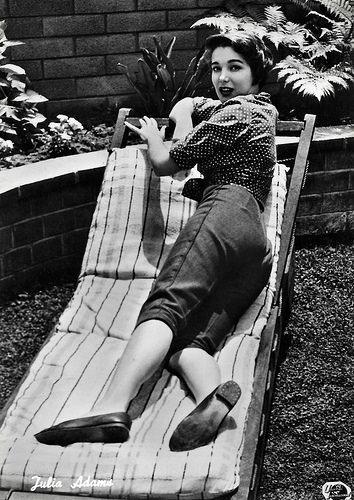
Italian postcard by Bromofoto, Milano, no. 1210. Photo: Universal International.
Miss Little Rock
Betty May Adams was born in 1926 in Waterloo, Iowa, but she grew up in Arkansas. Her Arkansas-born parents were Esther Gertrude (Beckett) and Ralph Adams, who was a cotton buyer. Betty made her acting debut in a third grade play, Hansel and Gretel.
When she grew up, Adams decided to become an actress. At age 19, she was crowned Miss Little Rock 1946 and she then moved to Los Angeles, California to pursue her acting career. There she worked three days a week as a secretary and spent the remainder of her time taking speech lessons and making the rounds at the various studios' casting departments.
Her first film role was playing a starlet, appropriately enough, in the Paramount musical Red, Hot and Blue (John Farrow, 1949) with Betty Hutton, followed by a leading role in the Lippert Western The Dalton Gang (Ford Beebe, 1949). Over a period of five weeks, she appeared in six more quickie Lippert Westerns. Robert L. Lippert was an American film producer and cinema owner who eventually owned a chain of 118 theatres. His 'Poverty Row' studio Lippert Pictures produced and released 130 B-Westerns between 1948 and 1955.
Adams' first big show biz break was at Universal, when she appeared in a screen test opposite All-American footballer Leon Hart, a Detroit Lions end. It was Hart who was being considered by the studio, but he flopped while Universal execs flipped over Adams. The studio changed her first name from Betty to Julia (and later to Julie).
Her main claim to fame became her role as bathing beauty Kay Lawrence in the black-and-white 3D monster horror film Creature from the Black Lagoon (Jack Arnold, 1954). Creature from the Black Lagoon received positive reviews from critics upon its release and is now considered a classic. Adams reportedly had to perform most of her own stunts.
I.S. Mowis at IMDb : "Shot in 3-D on a shoestring budget, the picture was light on script but strong on atmosphere and proved once again that style can succeed over content. The not inconsiderable physical charms of Miss Adams often dominated the scenery and gave the 'Gill Man' a run for his money. Audiences approved and 'Creature' spawned two further sequels, alas without Julia and with diminishing returns."
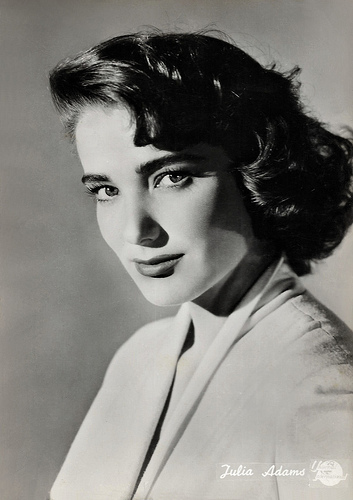
Italian postcard by Bromofoto, Milano, no. 551. Photo: Universal International.
Tickle Me
Julie Adams co-starred in several 1950s films opposite some of Hollywood's top leading men, including with James Stewart in Bend of the River (Anthony Mann, 1952), with Rock Hudson in The Lawless Breed (Raoul Walsh, 1953) and One Desire (Jerry Hopper, 1955), and with Tyrone Power in The Mississippi Gambler (Rudolph Maté, 1953).
She also appeared opposite Glenn Ford in The Man from the Alamo (Budd Boetticher, 1953), and with Joel McCrea in The Gunfight at Dodge City (Joseph M. Newman, 1959). Signed to a seven-year contract (and having her legs insured by Universal to the tune of $125,000 by Lloyds of London), Julia seemed destined to remain perpetually typecast as a western heroine.
But Adams also starred with George Nader and Elsa Martinelli in Four Girls in Town (Jack Sher, 1957), a romantic comedy about four young women competing for the leading role in a new film, featuring an international cast. And she appeared with Elvis Presley in the musical-comedy Tickle Me (Norman Taurog, 1965). Adams is also known for her TV roles as Paula Denning on Capitol and as Eve Simpson on Murder, She Wrote.
Julie Adams was married twice. Her first husband was writer-producer Leonard Stern (1951-1953; divorced). In 1955, she married actor Ray Danton , and they divorced in 1978. The couple had two sons: Steve Danton and Mitchell Danton. With Mitchell, she authored a book on her life and career, 'The Lucky Southern Star: Reflections From The Black Lagoon', which was published in 2011.
After her (voice) role in the film Carnage (Roman Polanski, 2011), she retired from acting at age 84. Julie Adams passed away on 3 February 2019 in Los Angeles, USA. She was 92.
Trailer Creature from the Black Lagoon (1954). Source: Humanoidity (YouTube).
Sources: (IMDb), Wikipedia and .

Italian postcard by Bromofoto, Milano, no. 1210. Photo: Universal International.
Miss Little Rock
Betty May Adams was born in 1926 in Waterloo, Iowa, but she grew up in Arkansas. Her Arkansas-born parents were Esther Gertrude (Beckett) and Ralph Adams, who was a cotton buyer. Betty made her acting debut in a third grade play, Hansel and Gretel.
When she grew up, Adams decided to become an actress. At age 19, she was crowned Miss Little Rock 1946 and she then moved to Los Angeles, California to pursue her acting career. There she worked three days a week as a secretary and spent the remainder of her time taking speech lessons and making the rounds at the various studios' casting departments.
Her first film role was playing a starlet, appropriately enough, in the Paramount musical Red, Hot and Blue (John Farrow, 1949) with Betty Hutton, followed by a leading role in the Lippert Western The Dalton Gang (Ford Beebe, 1949). Over a period of five weeks, she appeared in six more quickie Lippert Westerns. Robert L. Lippert was an American film producer and cinema owner who eventually owned a chain of 118 theatres. His 'Poverty Row' studio Lippert Pictures produced and released 130 B-Westerns between 1948 and 1955.
Adams' first big show biz break was at Universal, when she appeared in a screen test opposite All-American footballer Leon Hart, a Detroit Lions end. It was Hart who was being considered by the studio, but he flopped while Universal execs flipped over Adams. The studio changed her first name from Betty to Julia (and later to Julie).
Her main claim to fame became her role as bathing beauty Kay Lawrence in the black-and-white 3D monster horror film Creature from the Black Lagoon (Jack Arnold, 1954). Creature from the Black Lagoon received positive reviews from critics upon its release and is now considered a classic. Adams reportedly had to perform most of her own stunts.
I.S. Mowis at IMDb : "Shot in 3-D on a shoestring budget, the picture was light on script but strong on atmosphere and proved once again that style can succeed over content. The not inconsiderable physical charms of Miss Adams often dominated the scenery and gave the 'Gill Man' a run for his money. Audiences approved and 'Creature' spawned two further sequels, alas without Julia and with diminishing returns."

Italian postcard by Bromofoto, Milano, no. 551. Photo: Universal International.
Tickle Me
Julie Adams co-starred in several 1950s films opposite some of Hollywood's top leading men, including with James Stewart in Bend of the River (Anthony Mann, 1952), with Rock Hudson in The Lawless Breed (Raoul Walsh, 1953) and One Desire (Jerry Hopper, 1955), and with Tyrone Power in The Mississippi Gambler (Rudolph Maté, 1953).
She also appeared opposite Glenn Ford in The Man from the Alamo (Budd Boetticher, 1953), and with Joel McCrea in The Gunfight at Dodge City (Joseph M. Newman, 1959). Signed to a seven-year contract (and having her legs insured by Universal to the tune of $125,000 by Lloyds of London), Julia seemed destined to remain perpetually typecast as a western heroine.
But Adams also starred with George Nader and Elsa Martinelli in Four Girls in Town (Jack Sher, 1957), a romantic comedy about four young women competing for the leading role in a new film, featuring an international cast. And she appeared with Elvis Presley in the musical-comedy Tickle Me (Norman Taurog, 1965). Adams is also known for her TV roles as Paula Denning on Capitol and as Eve Simpson on Murder, She Wrote.
Julie Adams was married twice. Her first husband was writer-producer Leonard Stern (1951-1953; divorced). In 1955, she married actor Ray Danton , and they divorced in 1978. The couple had two sons: Steve Danton and Mitchell Danton. With Mitchell, she authored a book on her life and career, 'The Lucky Southern Star: Reflections From The Black Lagoon', which was published in 2011.
After her (voice) role in the film Carnage (Roman Polanski, 2011), she retired from acting at age 84. Julie Adams passed away on 3 February 2019 in Los Angeles, USA. She was 92.
Trailer Creature from the Black Lagoon (1954). Source: Humanoidity (YouTube).
Sources: (IMDb), Wikipedia and .
Published on February 05, 2019 22:00
February 4, 2019
Fräulein Wildfang (1916)
In Fräulein Wildfang (Friedrich Zelnik, 1916), sweet German actress Lisa Weise appeared in the title role. She starred in a dozen silent German films of the 1910s, and most of them, including Fräulein Wildfang, were directed and produced by Friedrich Zelnik. Her film partner, as in nearly all of her films, was Karl Beckersachs.
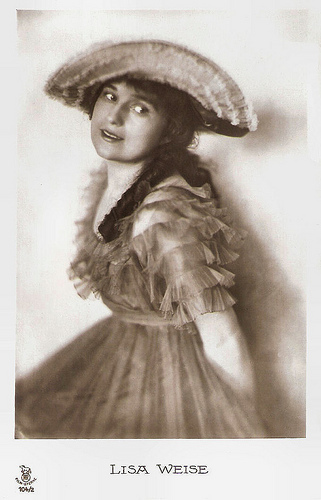
Lisa Weise . German postcard by Rotophot in the Film-Sterne series, no. 104/2.
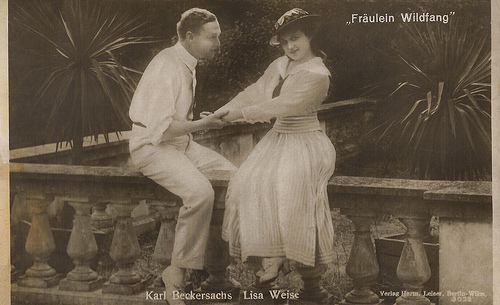
German postcard by Verlag Hermann Leiser, Berlin-Wilmersdorf, no. 3025. Photo: publicity still for Fräulein Wildfang (Friedrich Zelnik, 1916) with Karl Beckersachs and Lisa Weise .
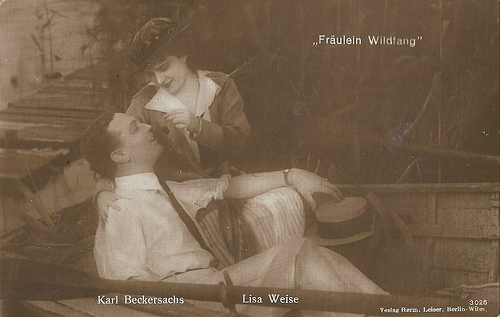
German postcard by Verlag Hermann Leiser, Berlin-Wilmersdorf, no. 3026. Photo: publicity still for Fräulein Wildfang (Friedrich Zelnik, 1916) with Karl Beckersachs and Lisa Weise .
One of the most beloved couples of the German cinema of the 1910s
In the middle of the First World War, the short romance Fräulein Wildfang (Friedrich Zelnik, 1916) was produced by the Berliner Film-Manufaktur GmbH, and released in June 1916. The two stars, Lisa Weise and Karl (or Carl) Beckersachs belonged to the pioneers of the German film actors. Beckersachs' career in the cinema had already begun in 1912, and the film debut of Lisa Weise was even two years earlier, in Der Graf von Luxemburg/The Count of Luxembourg (1910).
Lisa Weise and Karl Beckersachs were one of the most beloved romantic couples of the German cinema of the 1910s. Together, they appeared in such short silent films as Carl und Carla/Carl and Carla (Carl Wilhelm, 1915) in which Weise played both Carl and Carla, and Ein Zirkusmädel/A Circus Girl (Carl Wilhelm, 1916). Producer of the film was Friedrich Zelnik , later known as Frederic Zelnik.
Austrian actor Friedrich Zelnik made his film debut in Germany in 1914. From 1915 on, he also directed and produced film, while he remained acting in films by other directors. Zelnik directed most of the films with Weise and Beckersachs, including Das grosse Los/The big prize (1917), Klein Doortje (1917), based on the novel Little Dorrit by Charles Dickens, Edelweiß (1917) with Lupu Pick, and Durchlaucht Hypochonder/Highness hypochondriac (1917), for which Ewald André Dupont wrote the screenplay.
Their last films together were Gänseliesel/Goose Liesel (1918) and Der Liftjunge/The Elevator Boy (1918). Director Willy Zeyn directed in between another Beckersachs-Weise film, Amalie - 45 Mark (1918). After these films, Lisa Weise retired in 1918 and she vanished into obscurity. Completely forgotten by the public she died in 1952. Beckersachs remained appearing in films and made his 82th and final film in 1935.
Influential producer-director Friedrich Zelnik came to prominence in the Weimar cinema of the 1920s. He was the mentor of his actress-wife Lya Mara , whose films he directed and produced through their joint production company Zelnik-Mara Film GmbH. Lya Mara became one of the stars of the German silent cinema. Of Jewish background, he was forced to flee from Germany in 1933 and later continued making films in The Netherlands and Great Britain. Zelnik died in 1950 in London.
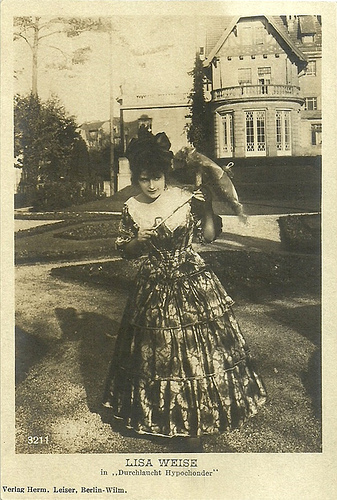
Lisa Weise. German postcard by Verlag Hermann Leiser, Berlin-Wilmersdorf, no. 3211. Photo: publicity still for Durchlaucht Hypochonder/Highness hypochondriac (Friedrich Zelnik, 1918).
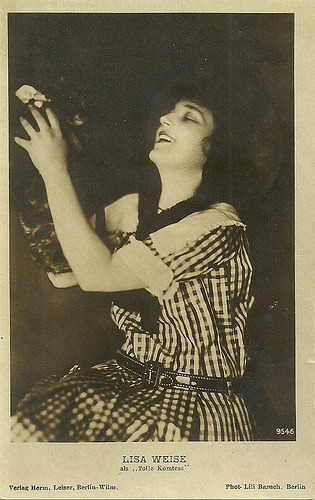
Lisa Weise. German postcard by Verlag Hermann Leiser, Berlin-Wilmersdorf, no. 9546. Photo: Lili Baruch, Berlin. Filmportal.de lists a 1915 film Die tolle Komtesse, produced by Messter, but gives no actors'names. Within the filmography of Lisa Weise on Filmportal.de this title is absent. Thomas Städeli at Cyranos writes that Hilde Wörner began her film career in this film. There is no mention of the film at our other sources.
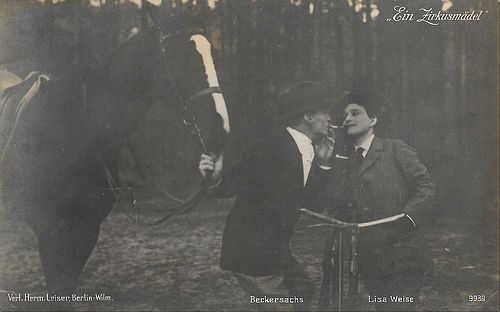
German postcard by Verlag Hermann Leiser, Berlin-Wilmersdorf, no. 9939. Photo: publicity still for Ein Zirkusmädel (Friedrich Zelnik, 1916) with Karl Beckersachs and Lisa Weise .
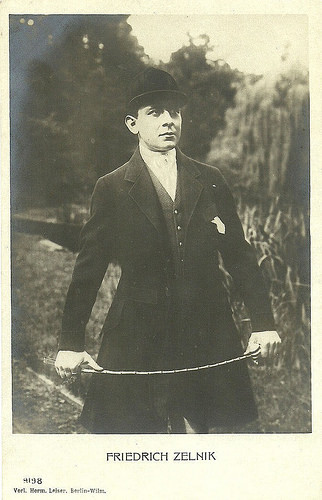
Friedrich Zelnik . German postcard by Verlag Hermann Leiser, Berlin-Wilmersdorf, no. 9198. Collection: Didier Hanson.
Sources: Stephanie d'Heil (Steffi-line.de), Thomas Städeli (Cyranos), Filmportal.de, Wikipedia and IMDb.

Lisa Weise . German postcard by Rotophot in the Film-Sterne series, no. 104/2.

German postcard by Verlag Hermann Leiser, Berlin-Wilmersdorf, no. 3025. Photo: publicity still for Fräulein Wildfang (Friedrich Zelnik, 1916) with Karl Beckersachs and Lisa Weise .

German postcard by Verlag Hermann Leiser, Berlin-Wilmersdorf, no. 3026. Photo: publicity still for Fräulein Wildfang (Friedrich Zelnik, 1916) with Karl Beckersachs and Lisa Weise .
One of the most beloved couples of the German cinema of the 1910s
In the middle of the First World War, the short romance Fräulein Wildfang (Friedrich Zelnik, 1916) was produced by the Berliner Film-Manufaktur GmbH, and released in June 1916. The two stars, Lisa Weise and Karl (or Carl) Beckersachs belonged to the pioneers of the German film actors. Beckersachs' career in the cinema had already begun in 1912, and the film debut of Lisa Weise was even two years earlier, in Der Graf von Luxemburg/The Count of Luxembourg (1910).
Lisa Weise and Karl Beckersachs were one of the most beloved romantic couples of the German cinema of the 1910s. Together, they appeared in such short silent films as Carl und Carla/Carl and Carla (Carl Wilhelm, 1915) in which Weise played both Carl and Carla, and Ein Zirkusmädel/A Circus Girl (Carl Wilhelm, 1916). Producer of the film was Friedrich Zelnik , later known as Frederic Zelnik.
Austrian actor Friedrich Zelnik made his film debut in Germany in 1914. From 1915 on, he also directed and produced film, while he remained acting in films by other directors. Zelnik directed most of the films with Weise and Beckersachs, including Das grosse Los/The big prize (1917), Klein Doortje (1917), based on the novel Little Dorrit by Charles Dickens, Edelweiß (1917) with Lupu Pick, and Durchlaucht Hypochonder/Highness hypochondriac (1917), for which Ewald André Dupont wrote the screenplay.
Their last films together were Gänseliesel/Goose Liesel (1918) and Der Liftjunge/The Elevator Boy (1918). Director Willy Zeyn directed in between another Beckersachs-Weise film, Amalie - 45 Mark (1918). After these films, Lisa Weise retired in 1918 and she vanished into obscurity. Completely forgotten by the public she died in 1952. Beckersachs remained appearing in films and made his 82th and final film in 1935.
Influential producer-director Friedrich Zelnik came to prominence in the Weimar cinema of the 1920s. He was the mentor of his actress-wife Lya Mara , whose films he directed and produced through their joint production company Zelnik-Mara Film GmbH. Lya Mara became one of the stars of the German silent cinema. Of Jewish background, he was forced to flee from Germany in 1933 and later continued making films in The Netherlands and Great Britain. Zelnik died in 1950 in London.

Lisa Weise. German postcard by Verlag Hermann Leiser, Berlin-Wilmersdorf, no. 3211. Photo: publicity still for Durchlaucht Hypochonder/Highness hypochondriac (Friedrich Zelnik, 1918).

Lisa Weise. German postcard by Verlag Hermann Leiser, Berlin-Wilmersdorf, no. 9546. Photo: Lili Baruch, Berlin. Filmportal.de lists a 1915 film Die tolle Komtesse, produced by Messter, but gives no actors'names. Within the filmography of Lisa Weise on Filmportal.de this title is absent. Thomas Städeli at Cyranos writes that Hilde Wörner began her film career in this film. There is no mention of the film at our other sources.

German postcard by Verlag Hermann Leiser, Berlin-Wilmersdorf, no. 9939. Photo: publicity still for Ein Zirkusmädel (Friedrich Zelnik, 1916) with Karl Beckersachs and Lisa Weise .

Friedrich Zelnik . German postcard by Verlag Hermann Leiser, Berlin-Wilmersdorf, no. 9198. Collection: Didier Hanson.
Sources: Stephanie d'Heil (Steffi-line.de), Thomas Städeli (Cyranos), Filmportal.de, Wikipedia and IMDb.
Published on February 04, 2019 22:00
February 3, 2019
Noi vivi (1942)
Alida Valli, Rossano Brazzi and Fosco Giachetti were the stars of the Italian film Noi Vivi/We the Living (Goffredo Alessandrini, 1942). The film - in two parts - was one of the biggest box office hits in Italy during the Second World War. It was an adaptation of We the Living, the debut novel of the Russian-American novelist Ayn Rand, published in 1936. The anti-authoritarian film was soon banned by the Fascist government and pulled from theatres. More than forty years later, Rand found, restored and released the forgotten film. It received rave reviews.
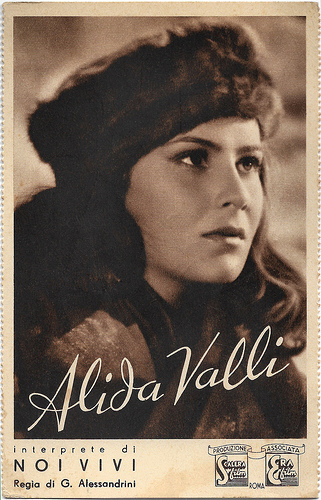
Alida Valli . Italian postcard by Zincografica, Firenze. Photo: Scalera Film / Era Film, Roma. Publicity still for Noi Vivi/We the Living (Goffredo Alessandrini, 1942).
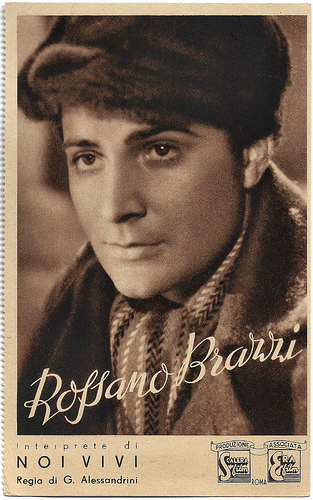
Rossano Brazzi . Italian postcard by Zincografica, Firenze. Sent by mail in 1942. Photo: Scalera Film / Era Film, Roma. Publicity still for Noi Vivi/We the Living (Goffredo Alessandrini, 1942).
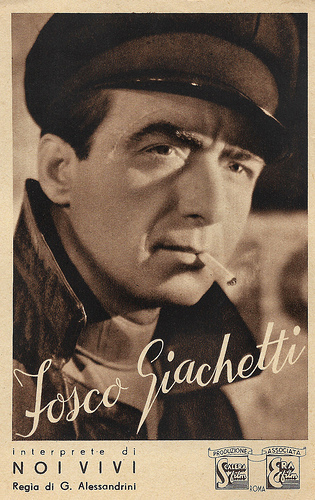
Fosco Giachetti . Italian postcard by Zincografica, Firenze. Photo: Scalera Film / Era Film, Roma. Publicity still for Noi Vivi/We the Living (Goffredo Alessandrini, 1942).
A fanatic student denounces her to the police
Ayn Rand's novel We the Living had been published in an Italian translation in 1937. When director Goffredo Alessandrini read the book, he immediately thought it would make an excellent screen epic. He never secured the film rights from Ayn Rand. Italy was at war with the United States and acquiring rights to the novel would be a major obstacle. The Fascist Ministry of Culture had set up special laws with regards to negotiations for rights and copyrights with enemy countries. So the film was made without the novelist's consent or knowledge, and no attempt was later made to compensate her.
Goffredo Alessandrini was a very successful director during Benito Mussolini's regime. His films are noted for their extreme realism, and have been lauded as anticipating the Neo-Realist movement that was to follow the end of the war. Taking advantage of the laisser-faire policy of the time, Alessandrini and his young associate director and screenwriter Anton Majano simply decided to use Rand's novel and base their screenplay on it.
They knew that We the Living touched on volatile political issues in Fascist Italy, but they hoped they would be safe from repercussions because of the story's negative portrayal of the Soviet Union, Italy's wartime enemy. It was approved for filming due to the intervention of dictator Benito Mussolini’s son Vittorio.
We the living is a tale of doomed love within a corrupt political world. In 1922, after the Soviet Revolution, 18-years old Kira Argounova ( Alida Valli ), the beautiful and smart daughter of impoverished traders, settles in St Petersburg to study engineering.
Kira rebuffs a cousin who rises in the Communist Party and may remember the slight. She has an affair with a mysterious young man, Leo Kovalenski ( Rossano Brazzi ), son of an executed czarist admiral. He gets into political trouble and flees. A fanatic student, Pavel Sjerov (Emilio Cigoli), denounces Kira to the police. Politic commissioner Andrei ( Fosco Giachetti ) falls in love with Kira during her arrest and tries to liberate her, raising suspicions.
Freed, Kira tries to flee abroad with Leo, but their boat is intercepted and sinks. They survive but Leo catches typhoid and needs to go to a sanatorium in Crimea. Kira goes to Andrei to ask for help and becomes Andrei's lover in return. But can Leo forgive her being Andrei's mistress?
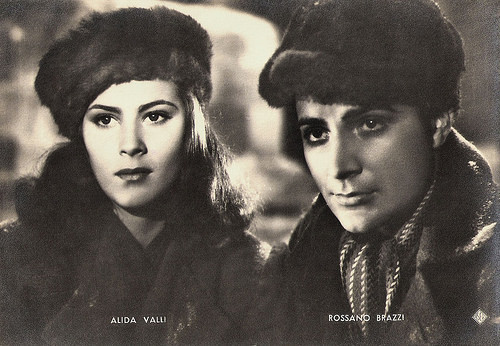
Italian postcard by ASER, no. 224. Photo: Pesce / Scalera Film. Publicity still for Noi Vivi/We the Living (Goffredo Alessandrini, 1942), with Alida Valli and Rossano Brazzi .
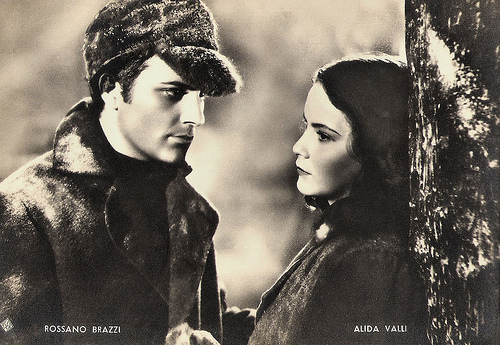
Italian postcard by ASER, no. 234. Photo: Pesce / Scalera Film. Publicity still for Noi Vivi/We the Living (Goffredo Alessandrini, 1942), with Rossano Brazzi and Alida Valli .
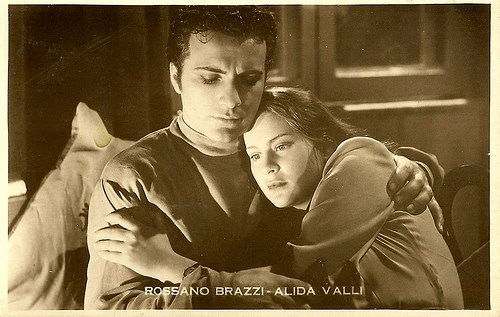
Italian postcard. Photo: publicity still for Noi Vivi/We the Living (Goffredo Alessandrini, 1942), with Rossano Brazzi and Alida Valli .
As much against fascism as against communism
Goffredo Alessandrini and screenwriter Anton Majano went with the screenplay to Scalera Films in Rome. The production company asked several other writers to rewrite scenes and alter the dialogue from the existing screenplay. The final draft ended up being so different from the screenplay produced by Alessandrini and Majano that they both decided to start shooting without a script and just follow the book. The pair wrote scenes at night and handed them to the actors in the morning. The result is an adaptation that is more faithful to the novel than is typical in film adaptations of the time.
The film starred Alida Valli , already a major star in Italy, as Kira, top box-office attraction Fosco Giachetti as Andrei, and the incredible handsome Rossano Brazzi as Leo. Many of the extras were White Russian emigres living in Rome. The production designers were also born in Russia. The whole film, even its exteriors, were shot at the studio lot of Scalera. Though the films were little censored by the fascist government as the delicate scenes were not shown to the censors, they were still permitted as the story itself was set in Soviet Russia and was directly critical of that regime.
As weeks went by, it soon became clear to Alessandrini and Majano that it would take longer than the customary three weeks of shooting to finish this film. They also realised that there was enough material for two films, but they chose not to share this information with the actors for fear they would demand to be paid double.
In September 1942, after nearly five months of shooting, the film was completed and presented at the Venice Film Festival where it was awarded the Volpi Cup. The film had a lukewarm reception among the press. Critics thought it to be too dark, long, and talkative. It went on general release in November of the same year as two separate films, Noi Vivi/We the Living and Addio Kira!/Goodbye Kira!. Audiences loved it and turned it into a huge commercial success. This not in the least because of the - then controversial - portrayal of an intelligent, sexually independent heroine.
The Italian public realised that the two films were as much against communism as against the Mussolini regime. Though some pro-Fascist lines had been added to the film, the story is as much an indictment of Fascism as it is of Communism. The Italian newspapers began objecting to it and saying that it was anti-Fascist, which it was, essentially. The authorities got wind of this and the film was banned. Though the film should have been destroyed, Massimo Ferrara, the studio chief for Scalera Films, hid the negative and offered the authorities a negative of another film to be demolished.
After the war, Scalera Film approached Ayn Rand to secure the literary rights to the film(s) so it could be re-released but she refused. Though Rand liked and was impressed by the film(s), she highly resented the distortion of her message with the addition of a few pro-Fascist additions to the film adaptation. A few years later, Scalera Films went into receivership and as part of the inventory of Scalera, both Noi Vivi and Addio Kira! were turned over to a holding company. The company relegated them to a vault where they remained for over twenty-five years.
The film was lost and forgotten for decades, until the late 1960s when Ayn Rand was able to locate the original nitrate negatives, still in good condition in the vault in Rome. Both films were restored, combined into one, and released (with English subtitles) in 1986 as We the Living at the Telluride Film festival in Colorado. There the film received rave reviews, over 44 years after its original release.
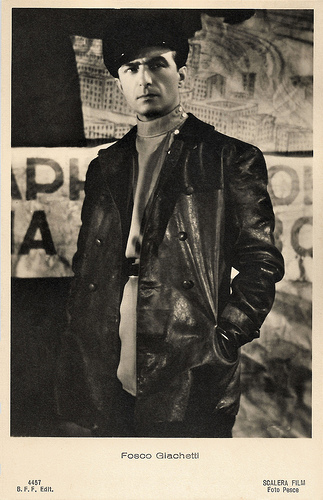
Italian postcard by B.F.F. Edit., no. 224. Photo: Pesce / Scalera Film. Publicity still for Noi Vivi/We the Living (Goffredo Alessandrini, 1942) with Fosco Giachetti .
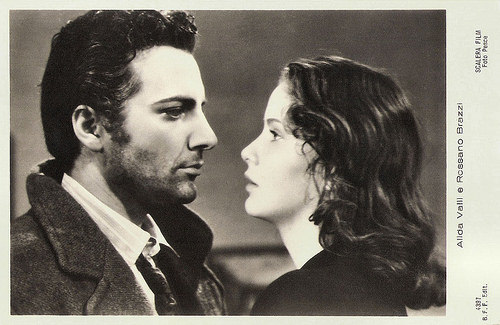
Italian postcard by Casa Editrice Ballerini & Fratini, Firenze (B.F.F. Edit.), no. 4397. Photo: Pesce / Scalera Film. Publicity still for Noi Vivi/We the Living (Goffredo Alessandrini, 1942), with Rossano Brazzi and Alida Valli
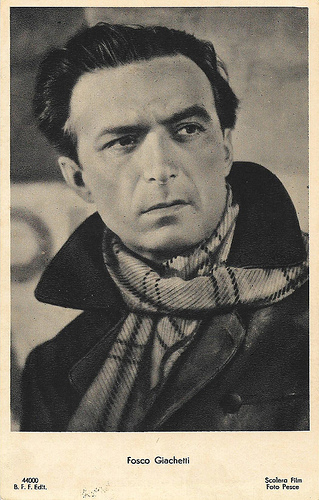
Italian postcard by B.F.F. Edit., no. 4400. Photo: Pesce / Scalera Film. Publicity still for Noi Vivi/We the Living (Goffredo Alessandrini, 1942) with Fosco Giachetti .
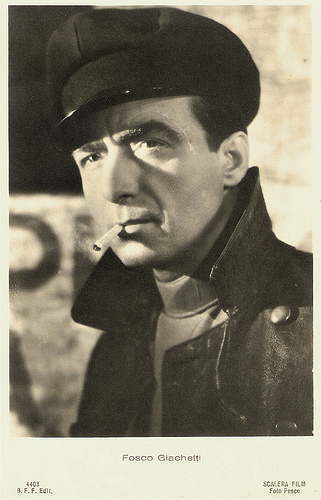
Italian postcard by B.F.F. Edit., no. 4423. Photo: Pesce / Scalera Film. Publicity still for Noi Vivi/We the Living (Goffredo Alessandrini, 1942) with Fosco Giachetti .
Sources: Wikipedia and IMDb.

Alida Valli . Italian postcard by Zincografica, Firenze. Photo: Scalera Film / Era Film, Roma. Publicity still for Noi Vivi/We the Living (Goffredo Alessandrini, 1942).

Rossano Brazzi . Italian postcard by Zincografica, Firenze. Sent by mail in 1942. Photo: Scalera Film / Era Film, Roma. Publicity still for Noi Vivi/We the Living (Goffredo Alessandrini, 1942).

Fosco Giachetti . Italian postcard by Zincografica, Firenze. Photo: Scalera Film / Era Film, Roma. Publicity still for Noi Vivi/We the Living (Goffredo Alessandrini, 1942).
A fanatic student denounces her to the police
Ayn Rand's novel We the Living had been published in an Italian translation in 1937. When director Goffredo Alessandrini read the book, he immediately thought it would make an excellent screen epic. He never secured the film rights from Ayn Rand. Italy was at war with the United States and acquiring rights to the novel would be a major obstacle. The Fascist Ministry of Culture had set up special laws with regards to negotiations for rights and copyrights with enemy countries. So the film was made without the novelist's consent or knowledge, and no attempt was later made to compensate her.
Goffredo Alessandrini was a very successful director during Benito Mussolini's regime. His films are noted for their extreme realism, and have been lauded as anticipating the Neo-Realist movement that was to follow the end of the war. Taking advantage of the laisser-faire policy of the time, Alessandrini and his young associate director and screenwriter Anton Majano simply decided to use Rand's novel and base their screenplay on it.
They knew that We the Living touched on volatile political issues in Fascist Italy, but they hoped they would be safe from repercussions because of the story's negative portrayal of the Soviet Union, Italy's wartime enemy. It was approved for filming due to the intervention of dictator Benito Mussolini’s son Vittorio.
We the living is a tale of doomed love within a corrupt political world. In 1922, after the Soviet Revolution, 18-years old Kira Argounova ( Alida Valli ), the beautiful and smart daughter of impoverished traders, settles in St Petersburg to study engineering.
Kira rebuffs a cousin who rises in the Communist Party and may remember the slight. She has an affair with a mysterious young man, Leo Kovalenski ( Rossano Brazzi ), son of an executed czarist admiral. He gets into political trouble and flees. A fanatic student, Pavel Sjerov (Emilio Cigoli), denounces Kira to the police. Politic commissioner Andrei ( Fosco Giachetti ) falls in love with Kira during her arrest and tries to liberate her, raising suspicions.
Freed, Kira tries to flee abroad with Leo, but their boat is intercepted and sinks. They survive but Leo catches typhoid and needs to go to a sanatorium in Crimea. Kira goes to Andrei to ask for help and becomes Andrei's lover in return. But can Leo forgive her being Andrei's mistress?

Italian postcard by ASER, no. 224. Photo: Pesce / Scalera Film. Publicity still for Noi Vivi/We the Living (Goffredo Alessandrini, 1942), with Alida Valli and Rossano Brazzi .

Italian postcard by ASER, no. 234. Photo: Pesce / Scalera Film. Publicity still for Noi Vivi/We the Living (Goffredo Alessandrini, 1942), with Rossano Brazzi and Alida Valli .

Italian postcard. Photo: publicity still for Noi Vivi/We the Living (Goffredo Alessandrini, 1942), with Rossano Brazzi and Alida Valli .
As much against fascism as against communism
Goffredo Alessandrini and screenwriter Anton Majano went with the screenplay to Scalera Films in Rome. The production company asked several other writers to rewrite scenes and alter the dialogue from the existing screenplay. The final draft ended up being so different from the screenplay produced by Alessandrini and Majano that they both decided to start shooting without a script and just follow the book. The pair wrote scenes at night and handed them to the actors in the morning. The result is an adaptation that is more faithful to the novel than is typical in film adaptations of the time.
The film starred Alida Valli , already a major star in Italy, as Kira, top box-office attraction Fosco Giachetti as Andrei, and the incredible handsome Rossano Brazzi as Leo. Many of the extras were White Russian emigres living in Rome. The production designers were also born in Russia. The whole film, even its exteriors, were shot at the studio lot of Scalera. Though the films were little censored by the fascist government as the delicate scenes were not shown to the censors, they were still permitted as the story itself was set in Soviet Russia and was directly critical of that regime.
As weeks went by, it soon became clear to Alessandrini and Majano that it would take longer than the customary three weeks of shooting to finish this film. They also realised that there was enough material for two films, but they chose not to share this information with the actors for fear they would demand to be paid double.
In September 1942, after nearly five months of shooting, the film was completed and presented at the Venice Film Festival where it was awarded the Volpi Cup. The film had a lukewarm reception among the press. Critics thought it to be too dark, long, and talkative. It went on general release in November of the same year as two separate films, Noi Vivi/We the Living and Addio Kira!/Goodbye Kira!. Audiences loved it and turned it into a huge commercial success. This not in the least because of the - then controversial - portrayal of an intelligent, sexually independent heroine.
The Italian public realised that the two films were as much against communism as against the Mussolini regime. Though some pro-Fascist lines had been added to the film, the story is as much an indictment of Fascism as it is of Communism. The Italian newspapers began objecting to it and saying that it was anti-Fascist, which it was, essentially. The authorities got wind of this and the film was banned. Though the film should have been destroyed, Massimo Ferrara, the studio chief for Scalera Films, hid the negative and offered the authorities a negative of another film to be demolished.
After the war, Scalera Film approached Ayn Rand to secure the literary rights to the film(s) so it could be re-released but she refused. Though Rand liked and was impressed by the film(s), she highly resented the distortion of her message with the addition of a few pro-Fascist additions to the film adaptation. A few years later, Scalera Films went into receivership and as part of the inventory of Scalera, both Noi Vivi and Addio Kira! were turned over to a holding company. The company relegated them to a vault where they remained for over twenty-five years.
The film was lost and forgotten for decades, until the late 1960s when Ayn Rand was able to locate the original nitrate negatives, still in good condition in the vault in Rome. Both films were restored, combined into one, and released (with English subtitles) in 1986 as We the Living at the Telluride Film festival in Colorado. There the film received rave reviews, over 44 years after its original release.

Italian postcard by B.F.F. Edit., no. 224. Photo: Pesce / Scalera Film. Publicity still for Noi Vivi/We the Living (Goffredo Alessandrini, 1942) with Fosco Giachetti .

Italian postcard by Casa Editrice Ballerini & Fratini, Firenze (B.F.F. Edit.), no. 4397. Photo: Pesce / Scalera Film. Publicity still for Noi Vivi/We the Living (Goffredo Alessandrini, 1942), with Rossano Brazzi and Alida Valli

Italian postcard by B.F.F. Edit., no. 4400. Photo: Pesce / Scalera Film. Publicity still for Noi Vivi/We the Living (Goffredo Alessandrini, 1942) with Fosco Giachetti .

Italian postcard by B.F.F. Edit., no. 4423. Photo: Pesce / Scalera Film. Publicity still for Noi Vivi/We the Living (Goffredo Alessandrini, 1942) with Fosco Giachetti .
Sources: Wikipedia and IMDb.
Published on February 03, 2019 22:00
February 2, 2019
Photo by Hepworth
One of the best known pioneers among the British film studios was Hepworth. Cecil M. Hepworth set up the production company Hepworth and Co. in 1898. It was later renamed the Hepworth Manufacturing Company, and then Hepworth Picture Plays. Hepworth produced the first film version of Alice in Wonderland in 1903 and the innovative Rescued by Rover in 1905. Among the most popular stars of the studio were Alma Taylor, Stewart Rome and the husband-and-wife-team of Henry Edwards and Chrissie White. In 1923 Hepworth Picture Plays went bankrupt.
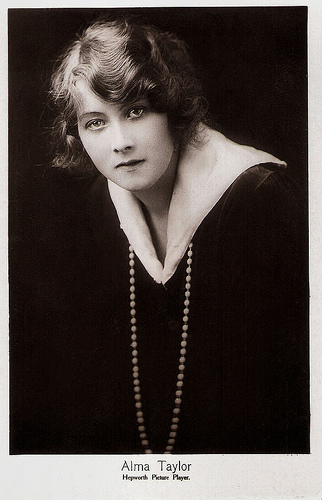
Alma Taylor . British postcard in the Hepworth Picture Player Series.
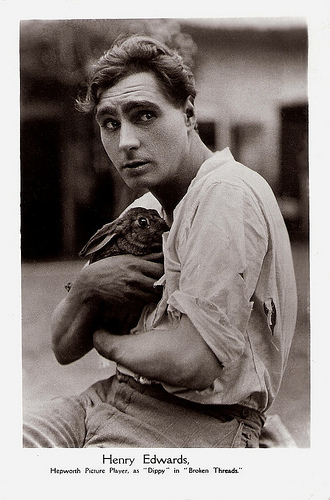
Henry Edwards . British postcard in the Hepworth Picture Player Series. Publicity still for Broken Threads (Henry Edwards, 1917) with Henry Edwards as Dippy.
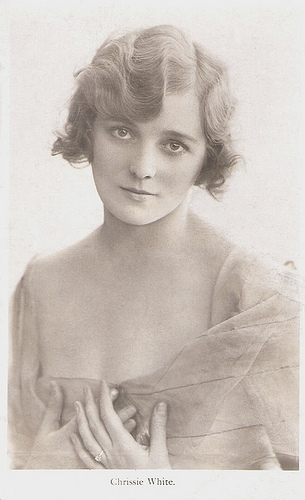
Chrissie White . British postcard. Photo: Hepworth Pictures.
Fascinated by the magic lantern
Cecil Milton Hepworth (1874-1953) was both director, producer and screenwriter. He was born in Lambeth, in present-day South London. His father, Thomas Cradock Hepworth, was a magic lantern showman and author. As a child, Cecil often travelled with his father when he lectured about magic lanterns. This fascinated the young Cecil, and he often cited it as an influence on his later inventions in pre-World War I British cinema.
Cecil M. Hepworth became involved in the early stages of British film making, and worked for both Birt Acres and Charles Urban, and wrote the first British book on the subject in 1897. In 1898, Cecil M. Hepworth and his cousin Monty Wicks set up the production company Hepworth and Co. in London. A year later, they built a small film studio in Walton-on-Thames, Hepworth Studios.
The company produced about three films a week, sometimes with Hepworth directing. An example is the first film version of Alice in Wonderland (Cecil M. Hepworth, Percy Stow, 1903). May Clark originally worked for Hepworth Film Studios as a film cutter and production secretary when she was cast as Alice. She would appear in 20 Hepworth films.
Hepworth became instrumental in developing the British film industry through his use of cutting to produce a coherent film narrative. Remarkable is his six minute film Rescued by Rover (Lewin Fitzhamon, Cecil M. Hepworth, 1905), featuring a faithful Collie who leads its master to his kidnapped baby. With shots being effectively combined to emphasise the action, the film is now regarded as an important development in film grammar.
Rescued by Rover was a family affair: Hepworth himself, his wife Margaret and their baby daughter Barbara are the family in the film, Rover is their own dog Blair, and Margaret also wrote the screenplay. The beggar and another minor character are played by professional actors, quite likely another first for British cinema.
In 1905, Rescued by Rover was a great success. Hepworth had to remake it twice to supply enough prints to meet demand. All with the same narrative, the original version is differentiable from the remakes via the scene where the nurse (May Clark) tells her boss that she lost the child. The original breaks the scene into two shots - the second shot being from a closer position. The two remakes contain only one shot, from the closer position, in that scene.
Hepworth patented several photographic inventions. He was also one of the first to recognise the potential of film stars, both animal and human, with several recurring characters appearing in his films. By 1910, Hepworth was also the inventor of Vivaphone, an early sound on disk system for adding sound to motion pictures. The device used phonograph records to record and play back the sound. Hepworth's Vivaphone was distributed in Britain and also in the United States and Canada.
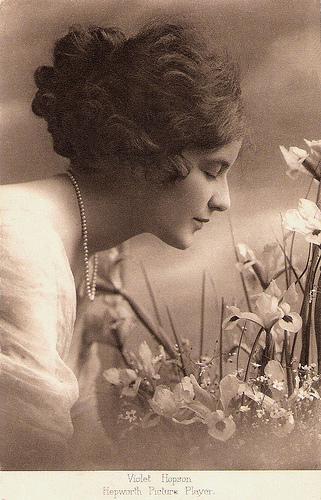
Violet Hopson . British postcard in the Hepworth Picture Player Series.
Australian-born actress and producer Violet Hopson (1887-1973) was one of the first British film stars. She appeared in more than 100 British silent films, and occasionally played supporting roles in sound pictures of the early 1930s.

Alma Taylor . British postcard in the Hepworth Picture Player Series.
Blue-eyed, round-faced Alma Taylor (1895-1974) was a British actress, who peeked in the British silent cinema of the 1910s and 1920s. In 1915 readers of Pictures and Picturegoers voted her most popular British performer, beating even Charlie Chaplin . Taylor acted in over 150 films.
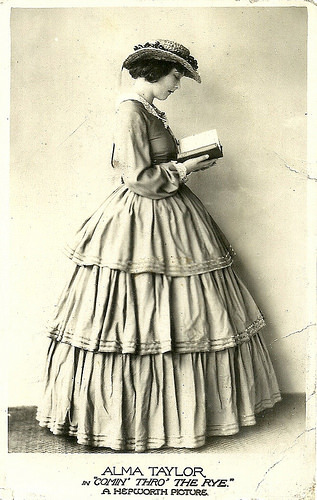
British postcard by TIC. Photo: Hepworth. Publicity still for Comin' Thro' the Rye (1923) with Alma Taylor .
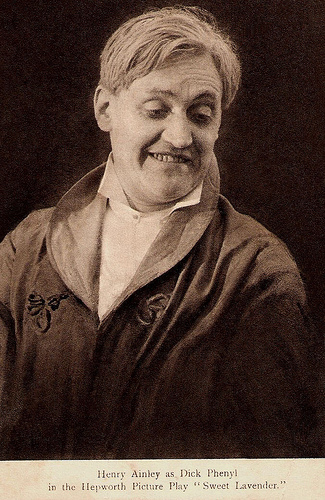
British postcard. Photo: Hepworth Pictures. Publicity still for Sweet Lavender (Cecil M. Hepworth, 1915) with Henry Ainley as Dick Phenyl.
Shakespeare performer Henry Ainley (1879-1945) was one of the first prominent stage actors to cross over into the world of film making. He played in some 20 silent films, but the stage was his real home.
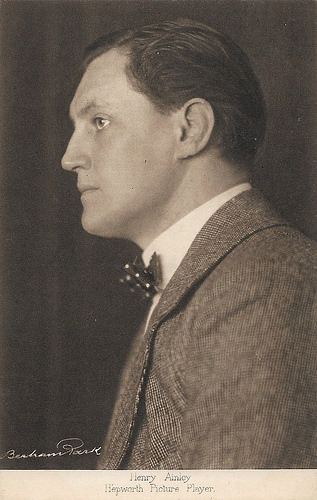
Henry Ainley . British postcard in the Hepworth Picture Player Series. Photo: Bertram Park.
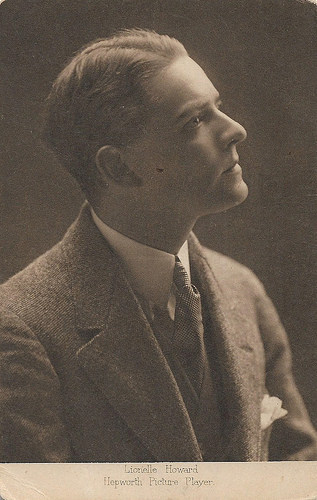
Lionelle Howard. British postcard in the Hepworth Picture Player Series.
Lionelle Howard (1886–1930) was a British silent film actor, who started his career in the early 1910s as secretary at Clarendon Films and was discovered in 1914 by director Wilfred Noy. After a series of short films at Clarendon, he stepped over to Hepworth, where he often acted together with Chrissie White and Stewart Rome . After a string of shorts at Hepworth, probably Howard's first feature film at Hepworth was the Dickens adaptation Barnaby Rudge (Thomas Bentley, Cecil M. Hepworth, 1915), with Tom Powers, Violet Hopson , Rome, and White. Still, in many of the Hepworth films he was often third actor, after Rome, White, Alma Taylor , and others. In the years after the First World War, Howard left Hepworth and got male leads at various other British companies.
An increasingly old-fashioned film style
In 1907 Cecil Hepworth hired two child actresses to play tragic young girls in his short silent films. The two girls, Alma Taylor and Chrissie White , co-starred in Hepworth's 'Tilly the Tomboy' comedy series (1910-1915) about two naughty schoolgirls. They were a hit. In those days, everyone helped out at the studios, so both Alma and Chrissie helped in the processing rooms when the weather was too poor to shoot.
Alma Taylor was Hepworth's favourite, and remained devoted to him for decades. She would appear in 75 or more short and long films by Hepworth, such as the Charles Dickens adaptations Oliver Twist (Thomas Bentley, 1912) as Nancy, David Copperfield (Thomas Bentley, 1913) and The Old Curiosity Shop (Thomas Bentley, 1913).
After a lull in film-making while attending more to his film studio business, Cecil M. Hepworth began making films again in 1914. During the First World War and soon after Hepworth contributed to the war effort with such propaganda films like The Nature of the Beast (Cecil Hepworth, 1919). Boosted by the international success of Alf's Button (Cecil M. Hepworth, 1920), the company went public to fund a large studio development, but Hepworth failed to raise the necessary capital.
Hepworth's film style did not change and became increasingly old-fashioned. In 1923, he directed Alma Taylor and Ralph Forbes in the British countryside drama Comin' Thro the Rye (Cecil M. Hepworth, 1923), a remake of an earlier version of 1916. It was a box office failure and the company went into receivership the next year. After his bankruptcy, Hepworth finished his career as a director of trailers and advertisements.
Cecil M. Hepworth died in 1953 in Greenford, Middlesex, England. He was 79. During his career he had produced more than 1600 short films and features. In 1924, all of the original film negatives in Hepworth's possession were melted down by the receiver in order to sell the silver. Hepworth's feature films have been considered lost for many decades. In 2008, an original 35mm print of his film Helen of Four Gates (Cecil M. Hepworth, 1920) starring Alma Taylor and Gerald Ames, was located in a film archive in Montreal, Canada.
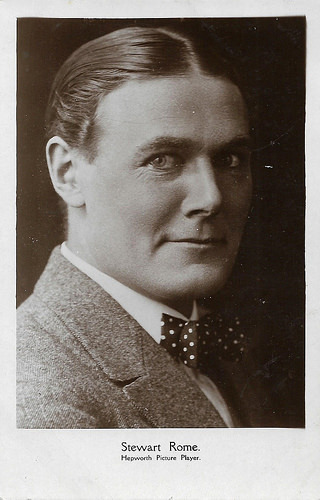
Stewart Rome . British postcard in the Hepworth Picture Player Series.
Stewart Rome (1886-1965) was a British actor of the silent screen. In the 1910s he was often paired with Alma Taylor and Chrissie White . In 1915 he was voted second to Chaplin in a Pictures magazine popularity poll. Rome played in over 120 films between 1913 and 1950.
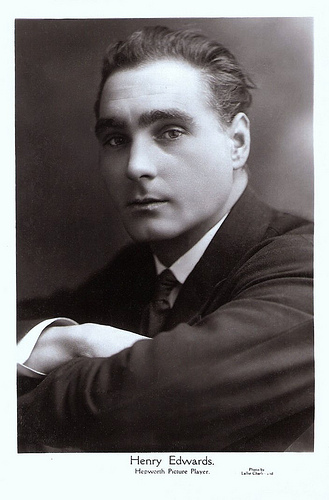
Henry Edwards . British postcard in the Hepworth Picture Player Series. Photo: Lallie Charles
Tall, British stage actor Henry Edwards (1882-1952) was in the silent period a famous star of the Hepworth studio. He was also active as an innovative film producer and director. Between 1914 and 1952 he appeared in 81 films and directed 67 films.
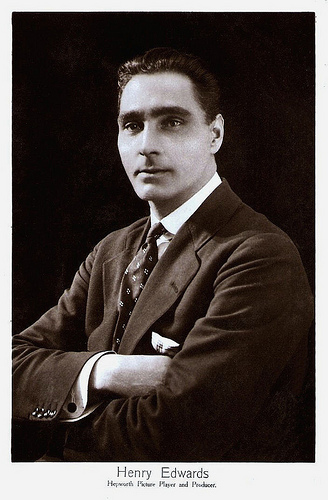
Henry Edwards . British postcard in the Hepworth Picture Player Series.
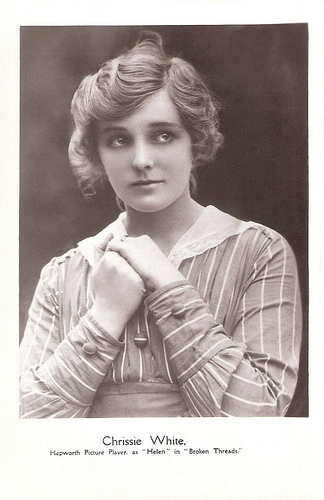
British postcard in the Hepworth Picture Player Series. Publicity still for Broken Threads (Henry Edwards, 1917) with Chrissie White as Helen.
Blue-eyed and light-haired beauty Chrissie White (1895-1989) was one of the most famous and popular stars of British silent cinema. In 1907 the 12-years old started at the Hepworth company and soon became a popular child star. In the 1920s, she and husband Henry Edwards were regarded as one of Britain's most newsworthy celebrity couples.
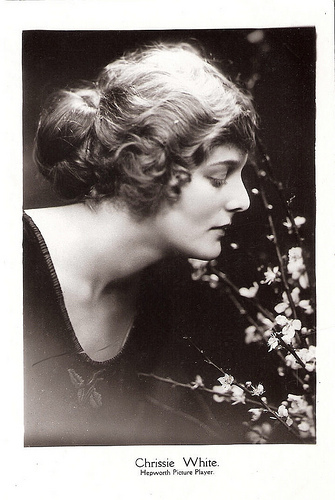
Chrissie White . British postcard in the Hepworth Picture Player Series.
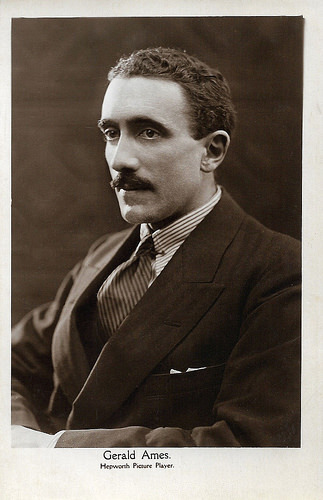
Gerald Ames. British postcard in the Hepworth Picture Player Series.
Gerald Ames (1880-1933) was a British actor, film director and Olympic fencer. In the post-First World War cinema, he was a popular leading man in the silent British cinema. Between 1914 and 1928. Ames appeared in more than seventy films.
Sources: (IMDb), Wikipedia and .

Alma Taylor . British postcard in the Hepworth Picture Player Series.

Henry Edwards . British postcard in the Hepworth Picture Player Series. Publicity still for Broken Threads (Henry Edwards, 1917) with Henry Edwards as Dippy.

Chrissie White . British postcard. Photo: Hepworth Pictures.
Fascinated by the magic lantern
Cecil Milton Hepworth (1874-1953) was both director, producer and screenwriter. He was born in Lambeth, in present-day South London. His father, Thomas Cradock Hepworth, was a magic lantern showman and author. As a child, Cecil often travelled with his father when he lectured about magic lanterns. This fascinated the young Cecil, and he often cited it as an influence on his later inventions in pre-World War I British cinema.
Cecil M. Hepworth became involved in the early stages of British film making, and worked for both Birt Acres and Charles Urban, and wrote the first British book on the subject in 1897. In 1898, Cecil M. Hepworth and his cousin Monty Wicks set up the production company Hepworth and Co. in London. A year later, they built a small film studio in Walton-on-Thames, Hepworth Studios.
The company produced about three films a week, sometimes with Hepworth directing. An example is the first film version of Alice in Wonderland (Cecil M. Hepworth, Percy Stow, 1903). May Clark originally worked for Hepworth Film Studios as a film cutter and production secretary when she was cast as Alice. She would appear in 20 Hepworth films.
Hepworth became instrumental in developing the British film industry through his use of cutting to produce a coherent film narrative. Remarkable is his six minute film Rescued by Rover (Lewin Fitzhamon, Cecil M. Hepworth, 1905), featuring a faithful Collie who leads its master to his kidnapped baby. With shots being effectively combined to emphasise the action, the film is now regarded as an important development in film grammar.
Rescued by Rover was a family affair: Hepworth himself, his wife Margaret and their baby daughter Barbara are the family in the film, Rover is their own dog Blair, and Margaret also wrote the screenplay. The beggar and another minor character are played by professional actors, quite likely another first for British cinema.
In 1905, Rescued by Rover was a great success. Hepworth had to remake it twice to supply enough prints to meet demand. All with the same narrative, the original version is differentiable from the remakes via the scene where the nurse (May Clark) tells her boss that she lost the child. The original breaks the scene into two shots - the second shot being from a closer position. The two remakes contain only one shot, from the closer position, in that scene.
Hepworth patented several photographic inventions. He was also one of the first to recognise the potential of film stars, both animal and human, with several recurring characters appearing in his films. By 1910, Hepworth was also the inventor of Vivaphone, an early sound on disk system for adding sound to motion pictures. The device used phonograph records to record and play back the sound. Hepworth's Vivaphone was distributed in Britain and also in the United States and Canada.

Violet Hopson . British postcard in the Hepworth Picture Player Series.
Australian-born actress and producer Violet Hopson (1887-1973) was one of the first British film stars. She appeared in more than 100 British silent films, and occasionally played supporting roles in sound pictures of the early 1930s.

Alma Taylor . British postcard in the Hepworth Picture Player Series.
Blue-eyed, round-faced Alma Taylor (1895-1974) was a British actress, who peeked in the British silent cinema of the 1910s and 1920s. In 1915 readers of Pictures and Picturegoers voted her most popular British performer, beating even Charlie Chaplin . Taylor acted in over 150 films.

British postcard by TIC. Photo: Hepworth. Publicity still for Comin' Thro' the Rye (1923) with Alma Taylor .

British postcard. Photo: Hepworth Pictures. Publicity still for Sweet Lavender (Cecil M. Hepworth, 1915) with Henry Ainley as Dick Phenyl.
Shakespeare performer Henry Ainley (1879-1945) was one of the first prominent stage actors to cross over into the world of film making. He played in some 20 silent films, but the stage was his real home.

Henry Ainley . British postcard in the Hepworth Picture Player Series. Photo: Bertram Park.

Lionelle Howard. British postcard in the Hepworth Picture Player Series.
Lionelle Howard (1886–1930) was a British silent film actor, who started his career in the early 1910s as secretary at Clarendon Films and was discovered in 1914 by director Wilfred Noy. After a series of short films at Clarendon, he stepped over to Hepworth, where he often acted together with Chrissie White and Stewart Rome . After a string of shorts at Hepworth, probably Howard's first feature film at Hepworth was the Dickens adaptation Barnaby Rudge (Thomas Bentley, Cecil M. Hepworth, 1915), with Tom Powers, Violet Hopson , Rome, and White. Still, in many of the Hepworth films he was often third actor, after Rome, White, Alma Taylor , and others. In the years after the First World War, Howard left Hepworth and got male leads at various other British companies.
An increasingly old-fashioned film style
In 1907 Cecil Hepworth hired two child actresses to play tragic young girls in his short silent films. The two girls, Alma Taylor and Chrissie White , co-starred in Hepworth's 'Tilly the Tomboy' comedy series (1910-1915) about two naughty schoolgirls. They were a hit. In those days, everyone helped out at the studios, so both Alma and Chrissie helped in the processing rooms when the weather was too poor to shoot.
Alma Taylor was Hepworth's favourite, and remained devoted to him for decades. She would appear in 75 or more short and long films by Hepworth, such as the Charles Dickens adaptations Oliver Twist (Thomas Bentley, 1912) as Nancy, David Copperfield (Thomas Bentley, 1913) and The Old Curiosity Shop (Thomas Bentley, 1913).
After a lull in film-making while attending more to his film studio business, Cecil M. Hepworth began making films again in 1914. During the First World War and soon after Hepworth contributed to the war effort with such propaganda films like The Nature of the Beast (Cecil Hepworth, 1919). Boosted by the international success of Alf's Button (Cecil M. Hepworth, 1920), the company went public to fund a large studio development, but Hepworth failed to raise the necessary capital.
Hepworth's film style did not change and became increasingly old-fashioned. In 1923, he directed Alma Taylor and Ralph Forbes in the British countryside drama Comin' Thro the Rye (Cecil M. Hepworth, 1923), a remake of an earlier version of 1916. It was a box office failure and the company went into receivership the next year. After his bankruptcy, Hepworth finished his career as a director of trailers and advertisements.
Cecil M. Hepworth died in 1953 in Greenford, Middlesex, England. He was 79. During his career he had produced more than 1600 short films and features. In 1924, all of the original film negatives in Hepworth's possession were melted down by the receiver in order to sell the silver. Hepworth's feature films have been considered lost for many decades. In 2008, an original 35mm print of his film Helen of Four Gates (Cecil M. Hepworth, 1920) starring Alma Taylor and Gerald Ames, was located in a film archive in Montreal, Canada.

Stewart Rome . British postcard in the Hepworth Picture Player Series.
Stewart Rome (1886-1965) was a British actor of the silent screen. In the 1910s he was often paired with Alma Taylor and Chrissie White . In 1915 he was voted second to Chaplin in a Pictures magazine popularity poll. Rome played in over 120 films between 1913 and 1950.

Henry Edwards . British postcard in the Hepworth Picture Player Series. Photo: Lallie Charles
Tall, British stage actor Henry Edwards (1882-1952) was in the silent period a famous star of the Hepworth studio. He was also active as an innovative film producer and director. Between 1914 and 1952 he appeared in 81 films and directed 67 films.

Henry Edwards . British postcard in the Hepworth Picture Player Series.

British postcard in the Hepworth Picture Player Series. Publicity still for Broken Threads (Henry Edwards, 1917) with Chrissie White as Helen.
Blue-eyed and light-haired beauty Chrissie White (1895-1989) was one of the most famous and popular stars of British silent cinema. In 1907 the 12-years old started at the Hepworth company and soon became a popular child star. In the 1920s, she and husband Henry Edwards were regarded as one of Britain's most newsworthy celebrity couples.

Chrissie White . British postcard in the Hepworth Picture Player Series.

Gerald Ames. British postcard in the Hepworth Picture Player Series.
Gerald Ames (1880-1933) was a British actor, film director and Olympic fencer. In the post-First World War cinema, he was a popular leading man in the silent British cinema. Between 1914 and 1928. Ames appeared in more than seventy films.
Sources: (IMDb), Wikipedia and .
Published on February 02, 2019 22:00
February 1, 2019
Johnny Lion (1941-2019)
On Thursday 31 January 2019, Dutch singer and actor Johnny Lion (1941-2019) passed away. From 1959 on, he had success with his band the Jumping Jewels. Solo, he had single luck with the evergreen Sophietje. He also appeared in some Dutch films.
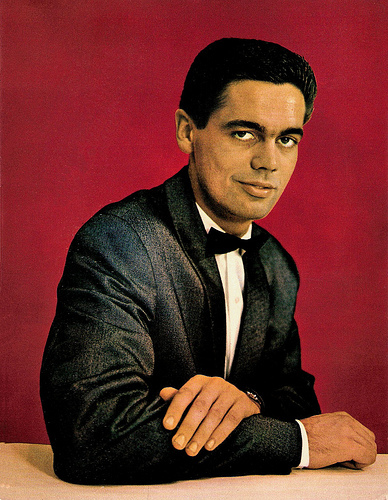
Big Dutch postcard by SYBA and MUVA. Photo: N.V. Phonogram, Amsterdam.
Johnny & His Jewels
Johnny Lion was born as Johannes Jacobus Petrus van Leeuwarden in The Hague in 1941. 'John' attended the Mulo and aspired to go into trade.
In 1959 he formed the band Johnny & His Jewels with a number of school friends, later renamed The Jumping Jewels. This group, formed after the commercial rocker Cliff Richard , scored a number one hit with 'Wheels' in 1961 and was then very successful in the Netherlands until 1965.
In that year, Van Leeuwarden left the group to continue as a Dutch-speaking solo singer, named Johnny Lion. This immediately earned him the great hit 'Sophietje' (1965), the Swedish song 'Fröken Fräken' by Thore Skogman on a Dutch text written by Gerrit den Braber and dedicated to his girlfriend and business partner Sophie van Kleef.
The following year he scored another hit with 'Tjingeling' and he opened a clothing boutique with the name 'Sophie and Johnny with Van Kleef'. This continued to exist until their relationship ended in 1969. After 'Tjingeling' he did not get any real hits anymore.
Lion appeared in the Dutch film Liefdesbekentenissen/Confessions of Loving Couples (Wim Verstappen, 1967) with Ramses Shaffy and Michael York . His clothing boutique with Sophie van Kleef was one of the sets of the film. He also got a fixed package to sing at the Circus Boltini, together with Dutch singer Rob de Nijs.
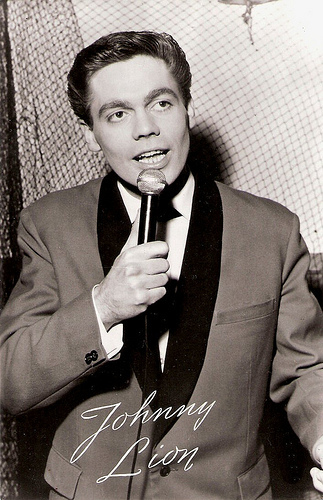
Dutch postcard by Uitg. Takken, Utrecht, no. AX 5447. Photo: Philips.
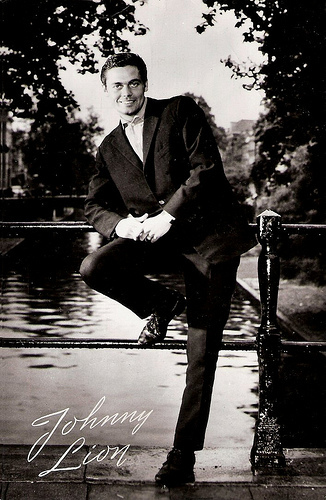
Dutch postcard by Uitg. Takken, Utrecht, no. AX 5487. Sent by mail in 1963.
In bed with Johnny Lion
In later years, Johnny Lion occasionally let himself be heard as a singer, including with the single 'Only in Dallas' (1988), which became a modest hit, and with the title song of the film Brandende Liefde/Burning Love (Ate de Jong, 1983), starring Monique van de Ven.
On these records he used the name John Lion. Van Leeuwarden had continued to work at Circus Boltini after his singing career, now as press officer. Later he also wrote columns for the weekly magazine Panorama and in 1995, he created for that magazine the series In bed with Johnny Lion, together with photographer Govert de Roos.
He also worked as a journalist for various magazines and newspapers, including ten years (2001-2011) as editor-in-chief of the SENA Performers Magazine.
Johnny Lion was also again active as an actor. He appeared in the Dutch features Siberia (Robert Jan Westdijk, 1998), with Roeland Fernhout, and Van God Los/Godforsaken (Pieter Kuijpers, 2003), starring Tygo Gernandt and Angela Schijf . He also played a washed-up folk singer, who contemplates suicide in the TV film Novellen: Hollandse held/Novels: Dutch hero (Robert-Jan Westdijk, 1996) with Tanja Jess.
Since the 1980s, Johnny Lion lived in Breda, in the south of the Netherlands. There he died on 31 January 2019, after a long illness. Johnny Lion was 77.
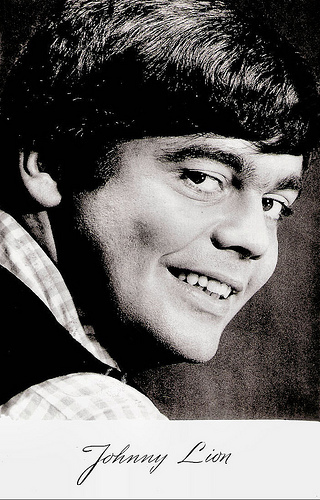
Dutch postcard by 't Sticht, Utrecht. Photo: Philips grammofoonplaten. Sent by mail in 1965.
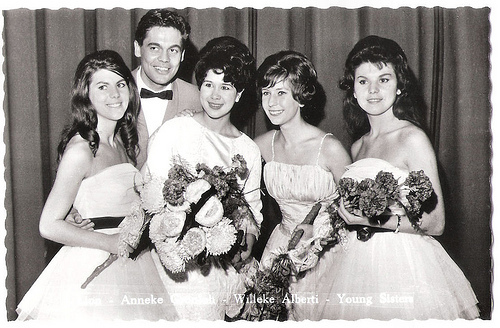
Johnny Lion with Anneke Grönloh, Willeke Alberti and the Young Sisters. Dutch postcard by N.V. v.h. Weenenk & Snel, Baarn, no. 963. Photo: Phonogram / Philips.
Johnny Lion sings Sophietje.
Sources: Wikipedia (Dutch) and .

Big Dutch postcard by SYBA and MUVA. Photo: N.V. Phonogram, Amsterdam.
Johnny & His Jewels
Johnny Lion was born as Johannes Jacobus Petrus van Leeuwarden in The Hague in 1941. 'John' attended the Mulo and aspired to go into trade.
In 1959 he formed the band Johnny & His Jewels with a number of school friends, later renamed The Jumping Jewels. This group, formed after the commercial rocker Cliff Richard , scored a number one hit with 'Wheels' in 1961 and was then very successful in the Netherlands until 1965.
In that year, Van Leeuwarden left the group to continue as a Dutch-speaking solo singer, named Johnny Lion. This immediately earned him the great hit 'Sophietje' (1965), the Swedish song 'Fröken Fräken' by Thore Skogman on a Dutch text written by Gerrit den Braber and dedicated to his girlfriend and business partner Sophie van Kleef.
The following year he scored another hit with 'Tjingeling' and he opened a clothing boutique with the name 'Sophie and Johnny with Van Kleef'. This continued to exist until their relationship ended in 1969. After 'Tjingeling' he did not get any real hits anymore.
Lion appeared in the Dutch film Liefdesbekentenissen/Confessions of Loving Couples (Wim Verstappen, 1967) with Ramses Shaffy and Michael York . His clothing boutique with Sophie van Kleef was one of the sets of the film. He also got a fixed package to sing at the Circus Boltini, together with Dutch singer Rob de Nijs.

Dutch postcard by Uitg. Takken, Utrecht, no. AX 5447. Photo: Philips.

Dutch postcard by Uitg. Takken, Utrecht, no. AX 5487. Sent by mail in 1963.
In bed with Johnny Lion
In later years, Johnny Lion occasionally let himself be heard as a singer, including with the single 'Only in Dallas' (1988), which became a modest hit, and with the title song of the film Brandende Liefde/Burning Love (Ate de Jong, 1983), starring Monique van de Ven.
On these records he used the name John Lion. Van Leeuwarden had continued to work at Circus Boltini after his singing career, now as press officer. Later he also wrote columns for the weekly magazine Panorama and in 1995, he created for that magazine the series In bed with Johnny Lion, together with photographer Govert de Roos.
He also worked as a journalist for various magazines and newspapers, including ten years (2001-2011) as editor-in-chief of the SENA Performers Magazine.
Johnny Lion was also again active as an actor. He appeared in the Dutch features Siberia (Robert Jan Westdijk, 1998), with Roeland Fernhout, and Van God Los/Godforsaken (Pieter Kuijpers, 2003), starring Tygo Gernandt and Angela Schijf . He also played a washed-up folk singer, who contemplates suicide in the TV film Novellen: Hollandse held/Novels: Dutch hero (Robert-Jan Westdijk, 1996) with Tanja Jess.
Since the 1980s, Johnny Lion lived in Breda, in the south of the Netherlands. There he died on 31 January 2019, after a long illness. Johnny Lion was 77.

Dutch postcard by 't Sticht, Utrecht. Photo: Philips grammofoonplaten. Sent by mail in 1965.

Johnny Lion with Anneke Grönloh, Willeke Alberti and the Young Sisters. Dutch postcard by N.V. v.h. Weenenk & Snel, Baarn, no. 963. Photo: Phonogram / Philips.
Johnny Lion sings Sophietje.
Sources: Wikipedia (Dutch) and .
Published on February 01, 2019 22:00
Paul van Yperen's Blog
- Paul van Yperen's profile
- 13 followers
Paul van Yperen isn't a Goodreads Author
(yet),
but they
do have a blog,
so here are some recent posts imported from
their feed.



